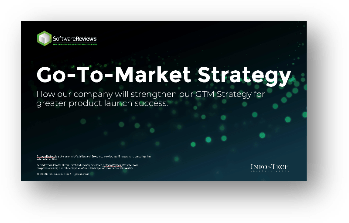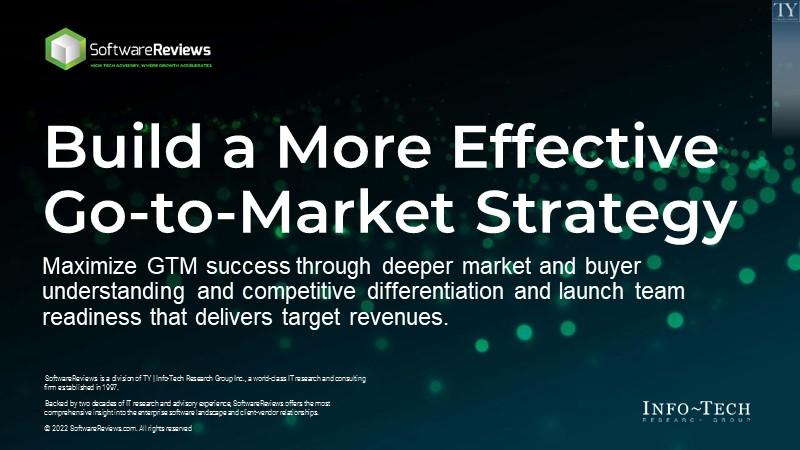
Build a More Effective Go-to-Market Strategy
- A weak or poorly defined Go-to-Market strategy is often the root cause of slow product revenue growth or missed product revenue targets.
- Many agile-driven product teams rush to release, skipping key GTM steps leaving Sales and Marketing misaligned and not ready to fully monetize precious product investments.
- Guessing at buyer persona and journey or competitive SWOT analyses – two key deliverables of an effective GTM strategy – cause poor marketing and sales outcomes.
- Without the sales and product-aligned business case for launch called for in a successful GTM strategy, companies see low buyer adoption, wasted sales and marketing investments, and a failure to claim product and launch campaign success.
Our Advice
Critical Insight
- Having an updated and compelling Go-to-Market strategy is a critical capability – as important as financial strategy, sales operations, and even corporate business development, given its huge impact on the many drivers of sustainable growth.
- Establishing alignment through the GTM process builds long-term operational strength.
- With a sound GTM strategy, marketers give themselves a 50% greater chance of product launch success.
Impact and Result
- Align stakeholders on a common vision and execution plan prior to the Build and Launch phases.
- Build a foundation of buyer and competitive understanding to drive a successful product hypothesis, then validate with buyers.
- Deliver a team-aligned launch plan that enables launch readiness and outlines commercial success.
Build a More Effective Go-to-Market Strategy Research & Tools
Build Your Go-to-Market Strategy
Use this storyboard and its deliverables to build a baseline market, understand your buyer, and gain competitive insights. It will also help you design your initial product and business case, and align stakeholder plans to prep for build.Besides the small introduction, subscribers and consulting clients within this management domain have access to:
- Build a More Effective Go-to-Market Strategy – Phases 1-3
- Go-to-Market Strategy Presentation Template
- Go-to-Market Strategy RACI and Launch Checklist Workbook
- Product Market Opportunity Sizing Workbook
- Go-to-Market Strategy Cost Budget and Revenue Forecast Workbook
Infographic
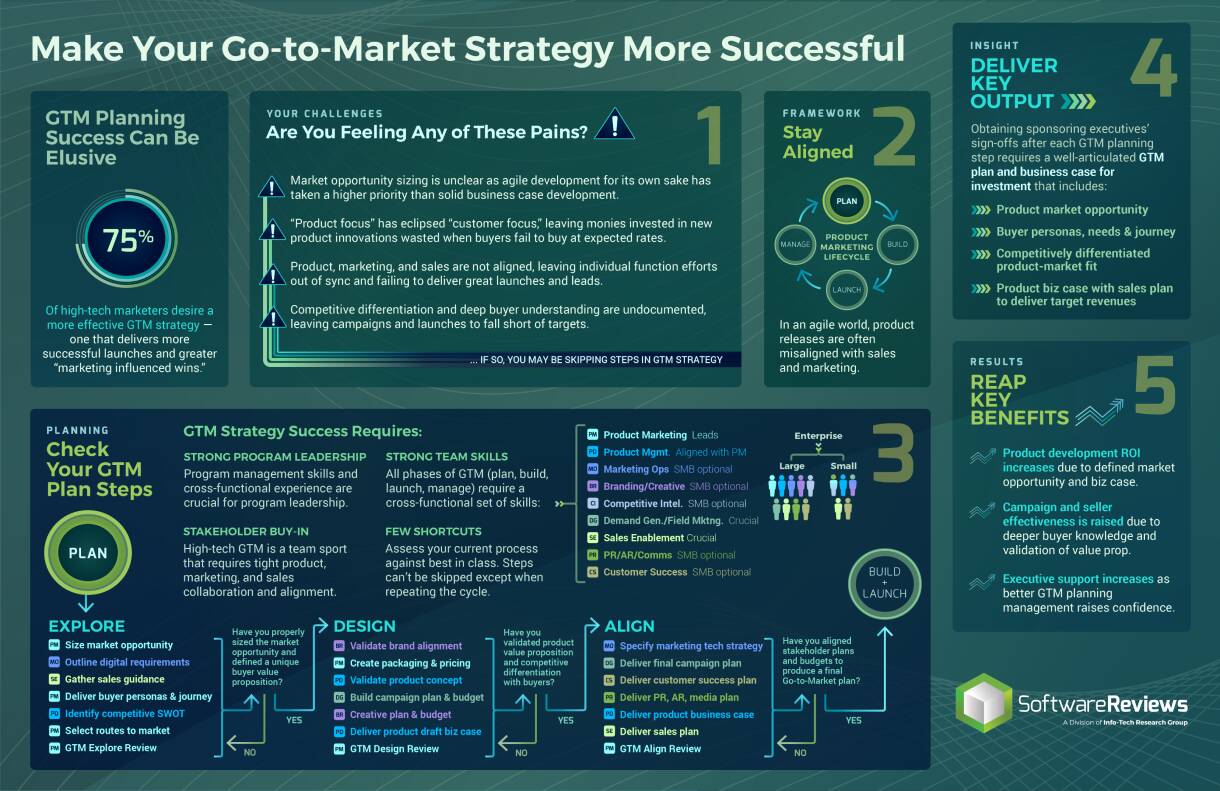
Workshop: Build a More Effective Go-to-Market Strategy
Workshops offer an easy way to accelerate your project. If you are unable to do the project yourself, and a Guided Implementation isn't enough, we offer low-cost delivery of our project workshops. We take you through every phase of your project and ensure that you have a roadmap in place to complete your project successfully.
1 Align on GTM Vision & Plan, Craft Initial Strategy
The Purpose
Align on GTM vision and plan; craft initial strategy.
Key Benefits Achieved
Confidence that market opportunity is sufficient.
Deeper buyer understanding to drive product design and messaging and launch campaign asset design.
Steering committee approval for next phase.
Activities
1.1 Outline a vision for GTM, roles required, identify Steering Committee lead, workstream leads, and teams.
1.2 Capture GTM strategy hypothesis by working through initial draft of the Go-to-Market Strategy Presentation and business case.
1.3 Capture team knowledge on buyer persona and journey and competitive SWOT.
1.4 Identify info./data gaps, sources, and plan for capturing/gathering including buyer interviews.
Outputs
Documented Steering Committee and Working team.
Aligned on GTM vision and process.
Documented buyer persona and journey. Competitive SWOT analysis.
Document team knowledge on initial GTM strategy, buyer personas, and business case.
2 Identify Initial Business Case, Sales Forecast, and Launch Plan
The Purpose
Identify Initial Business Case, Sales Forecast, and Launch Plan.
Key Benefits Achieved
Confidence in size of market opportunity.
Alignment of Sales and Product on product forecast.
Assessment of marketing tech stack.
Initial business case.
Activities
2.1 Size Product Market Opportunity and initial revenue forecast.
2.2 Craft initial product hypothesis from buyer interviews including feature priorities, pricing, packaging, competitive differentiation, channel/route to market.
2.3 Craft initial launch campaign, product release and sales and CX readiness plans.
2.4 Identify launch budgets across each investment area.
2.5 Discuss initial product launch business case and key activities.
Outputs
Product Serviceable Obtainable Market (SOM), Serviceable Available Market (SAM) and Total Available Market (TAM).
Definition of product-market fit, uniqueness, and competitive differentiation.
Preliminary campaign, targets, and readiness plans.
Incremental budgets for each key stakeholder area.
Preliminary product launch business case.
3 Develop Launch Plans (I of II)
The Purpose
Develop final Launch plans and budgets in product and marketing.
Key Benefits Achieved
Align Product release/launch plans with the marketing campaign for launch.
Understand incremental budgets from product and marketing for launch.
Activities
3.1 Apply product interviews to scope, MVP, roadmap, competitive differentiation, pricing, feature prioritization, routes to market, and sales forecast.
3.2 Develop a more detailed launch campaign plan complete with asset-types, messaging, digital plan to support buyer journey, media buy plan and campaign metrics.
Outputs
Minimally Viable Product defined with feature prioritization. Product competitive differentiation documented Routes to market identified Sales forecast aligned with product team expectations.
Marketing campaign launch plan Content marketing asset-creation/acquisition plan Campaign targets and metrics.
4 Develop Launch Plans (II of II)
The Purpose
Develop final Launch Plans and budgets for remaining areas.
Key Benefits Achieved
Align Product release/launch plans with the marketing campaign for launch.
Understand incremental budgets from Product and Marketing for launch.
Activities
4.1 Develop detailed launch/readiness plans with final budgets for: Sales enablement , Sales training, Tech stack, Customer onboarding & success, Product marketing, AR, PR, Corp Comms/Internal Comms, Customer Events, Employee Events, etc.
Outputs
Detailed launch plans, budgets for Product Marketing, Sales, Customer Success, and AR/PR/Corp. Comms.
5 Present Final Business Case
The Purpose
To gain approval to move to Build and Launch phases.
Key Benefits Achieved
Align business case with Steering Committee expectations
Approvals to Build and Launch targeted offering
Activities
5.1 Review final launch/readiness plans with final budgets for all key areas.
5.2 Move all key findings into Steering Committee presentation slides.
5.3 Present to Steering Committee; receive feedback.
5.4 Incorporate Steering Committee feedback; update finial business case.
Outputs
Combined budgets across all areas. Final launch/readiness plans.
Final Steering Committee-facing slides.
Final approvals for Build and Launch.
Further reading
Build a More Effective Go-to-Market Strategy
Maximize GTM success through deeper market and buyer understanding and competitive differentiation and launch team readiness that delivers target revenues.
Table of Contents
| Section | Title |
| 1 | Executive Brief
|
| 2 | Build baseline market, buyer, and competitive insights
|
| 3 | Design initial product and business case
|
| 4 | Align stakeholder plans to prep for build
|
Executive Brief
Analyst Perspective
Go-to-Market Strategy.
A successful go-to-market (GTM) strategy aligns marketing, product, sales and customer success, sees decision making based on deep buyer understanding, and tests many basic assumptions often overlooked in today’s agile-driven product development/management environment.
The disciplines you build using our methodology will not only support your team’s effort building and launching more successful products, but also can be modified for use in other strategic initiatives such as branding, M&A integration, expanding into new markets, and other initiatives that require a cross-functional and multidisciplined process.

|
Jeff Golterman
|
Executive Summary
An ineffective go-to-market strategy is often a root cause of:
|
Hurdles to go-to-market success include:
|
Apply SoftwareReviews approach for greater GTM success.
Our blueprint is designed to help you:
|
SoftwareReviews Insight
Creating a compelling go-to-market strategy, and keeping it current, is a critical software company function – as important as financial strategy, sales operations, and even corporate business development – given its huge impact on the many drivers of sustainable growth.
Go-to-Market Strategy Critical Success Factors
Your GTM Strategy is where a multi-disciplined team builds a strong foundation for overall product plan, build, launch, and manage success
A GTM Strategy is not all art and not all science but requires both. Software leaders will establish a set of core capabilities upon which they will plan, build, launch and manage product success. Executives, when resourcing their GTM strategies, will begin with:
|
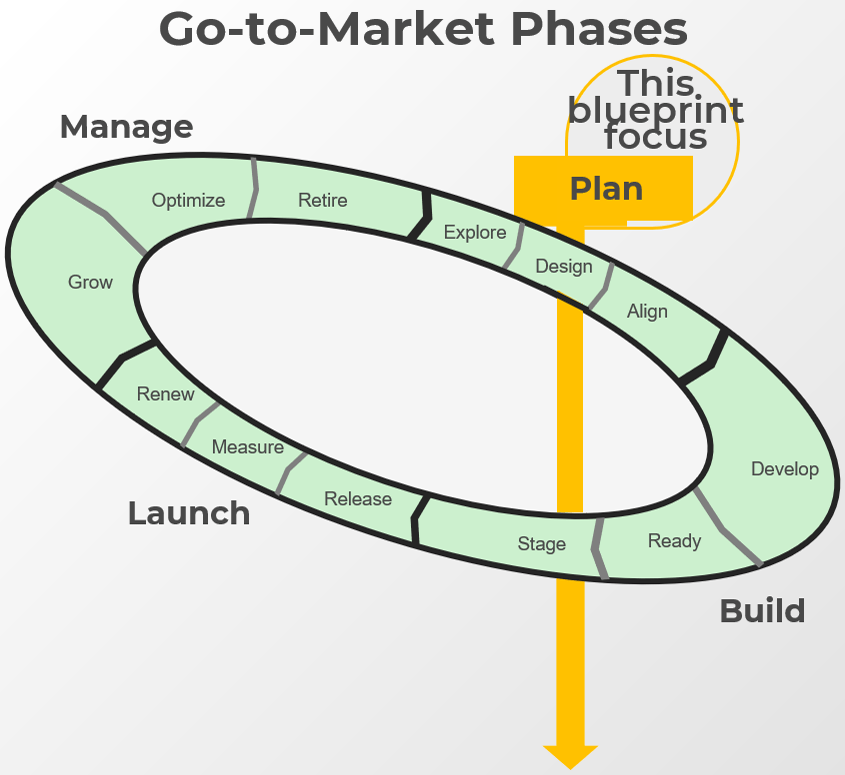
|
|
SoftwareReviews Advisory Insight:
Marketers who get GTM Strategy “right” give themselves a 50% greater chance of Build and Launch success.
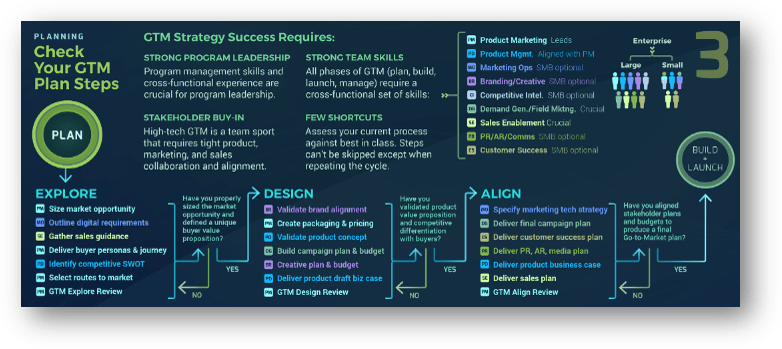
Go-to-Market Success is Challenging
Getting GTM right is like winning an Olympic first-place crew finish. It takes teamwork, practice, and well-functioning tools and equipment.

- The goal of any Go-to-Marketing Strategy is not only to do it right once, but to do it over and over consistently.
- A lack of GTM consistency often results in decelerating growth, and a weak GTM Strategy is likely the root cause when companies observe any of the following challenges:
- Product opportunity is unclear and well-defined business cases are lacking
- Buyer adoption slows of new features and launch revenue targets are missed
- Sales and marketing are not ready when development releases new features
- Sales win/loss ratios drop as customers tell us products are not competitively differentiated
- Loss of executive support for new product investments
- A company experiencing any one of these symptoms will find a remedy in plugging gaps in the way they Go-to-Market.
“Figuring out a Go-to-Market approach is no trivial exercise – it separates the companies that will be successful and sustainable from those that won’t.” (Harvard Business Review)
Slowing growth may be due to missing GTM Strategy essentials
Marketers – Large and Small – will further test their GTM Strategy strength by asking “Are we missing any of the following?”
- Product, Marketing, and Sales Alignment
- Buyer personas and journeys
- Product market opportunity size
- Competitively differentiated product hypothesis
- Buyer validated commercial concept
- Sales revenue plan and program cost budget
- Compelling business case for build and launch
SoftwareReviews Advisory Insight:
Marketers will go through the GTM Strategy process together across all disciplines at least once in order to establish a consistent process, make key foundational decisions (e.g. tech stack, channel strategy, pricing structure, etc.), and assess strengths and weaknesses to be addressed. Future releases to existing products don’t need to be re-thought but instead check-listed against prior foundational decisions.
Is Your GTM Strategy Led and Staffed Properly?
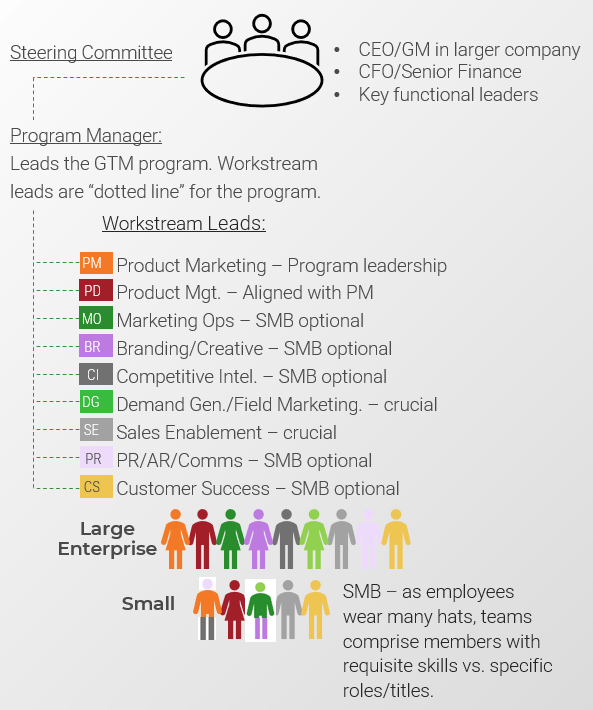
Benefits of a more effective go-to-market strategy
Our research shows a more effective GTM Strategy delivers key benefits, including:
SoftwareReviews Advisory Insight:
|
“Go-to-Market Strategies aren’t just for new products or services, they can also be used for:
And while each GTM strategy is unique, there are a series of steps that every product marketer should follow.” (Product Marketing Alliance) |
Is your GTM Strategy optimized?
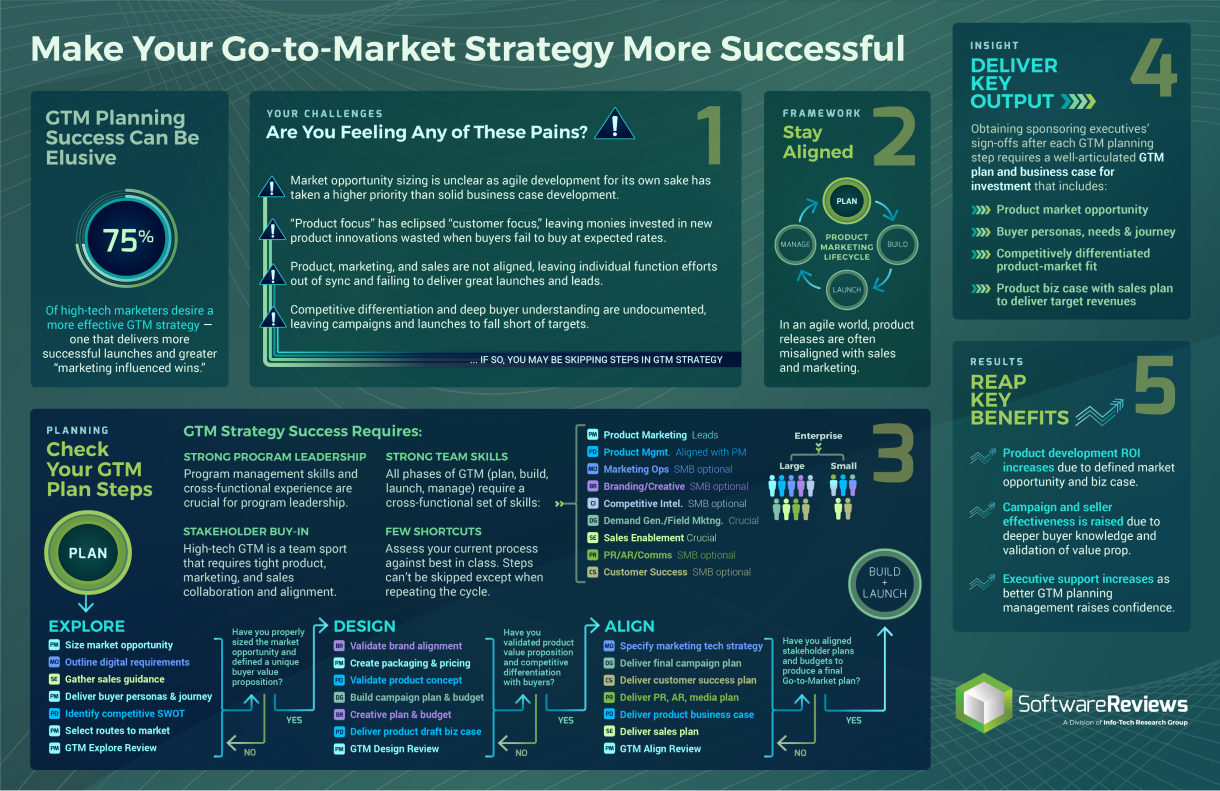
Marketers, in order to optimize a go-to-market strategy, will:
- Self assess for symptoms of a sub-optimized approach.
- Align marketing, sales, product, and customer success with a common vision and execution plan.
- Diagnose for missing steps.
- Ensure creation of key deliverables.
- And then be able to reap the rewards.
Who benefits from an optimized go-to-market strategy?
This research is designed for:
|
This research will help you:
|
This research will also assist:
|
This research will help them:
|
SoftwareReviews’ Approach
1 |
Build baseline market, buyer, and competitive insights
Sizing your opportunity, building deep buyer understanding, competitive differentiation, and routes to market are fundamental first steps. |
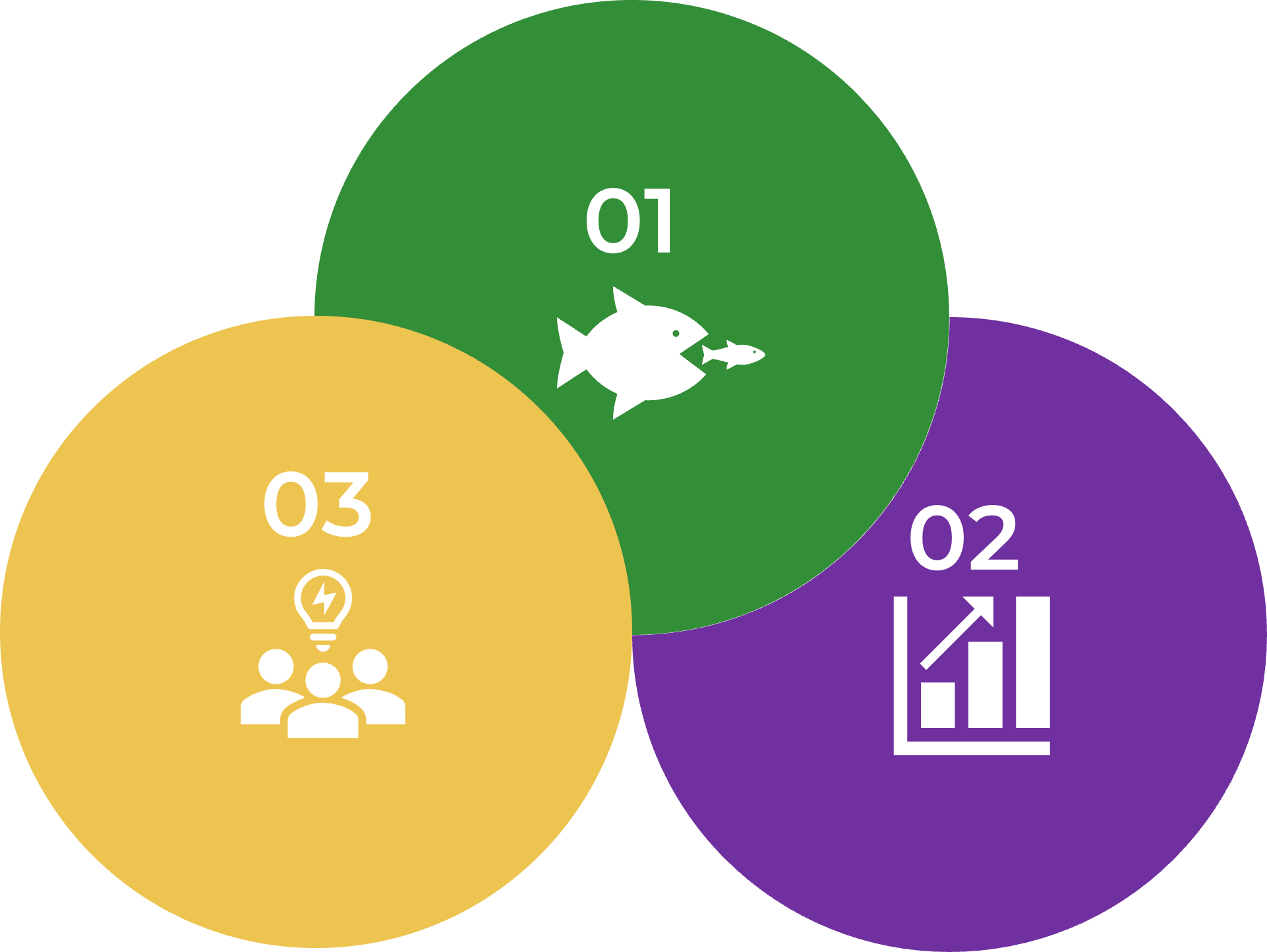
|
2 |
Design initial product and business case
Validate positioning and messaging against brand, develop packaging and pricing, and develop digital approach, launch campaign approach and supporting budgets across all areas. |
|
3 |
Align stakeholder plans to prep for build
Rationalize product release and concept to sales/financial plan and further develop customer success, PR/AR, MarTech, and analytics/metrics plans. |
Our methodology provides a step-by-step approach to build a more effective go-to-market strategy
| 1.Build baseline market, buyer, and competitive insights | 2. Design initial product and business case | 3. Align stakeholder plans to prep for build | |
| Phase Steps |
|
|
|
| Phase Outcomes |
|
|
|
Insight summary
Your go-to-market strategy ability is a strategic asset
Having an updated and compelling go-to-market strategy is a critical capability – as important as financial strategy, sales operations, and even corporate business development – given its huge impact on the many drivers of sustainable growth.
Build the GTM Steering Committee into a strategic decision-making body
Many marketers experiencing the value of the GTM Steering Committee extend its use into a “Product and Pricing Council” (PPC) in order to move product-related decision making from ad-hoc to structured, and to reinforce GTM Strategy guardrails and best practices across the company.
A strong MarTech apps and analytics stack differentiates GTM leaders from laggards
Marketers that collaborate closely with Marketing Ops., Sales Ops., and IT early in the process of a go-to-market strategy will be best able to assess whether current website/digital, marketing applications, CRM/sales automation apps, and tools can support the complete Go-to-Market process effectively.
Establishing alignment through the GTM process builds long term operational strength
Marketers will go through the GTM Strategy process together across all disciplines at least once in order to establish a consistent process, make key foundational decisions (e.g. tech stack, channel strategy, pricing structure, etc.), and assess strengths and weaknesses to be addressed.
Build speed and agility
Future releases to existing products don’t need be re-thought but instead check-listed against prior foundational decisions.
GTM Strategy builds launch success
Marketers who get GTM Strategy “right” give themselves a 50% greater chance of build and launch success.
Blueprint deliverables
Each step of this blueprint is accompanied by supporting deliverables to help you accomplish your goals:
Key deliverable:
Go-to-Market Strategy Presentation TemplateCapture key findings for your GTM Strategy within the Go-to-Market Strategy Presentation Template.
|
Go-to-Market Strategy RACI and Launch Checklist WorkbookIncludes a RACI model and launch checklist that helps scope your working team’s roles and responsibilities. |
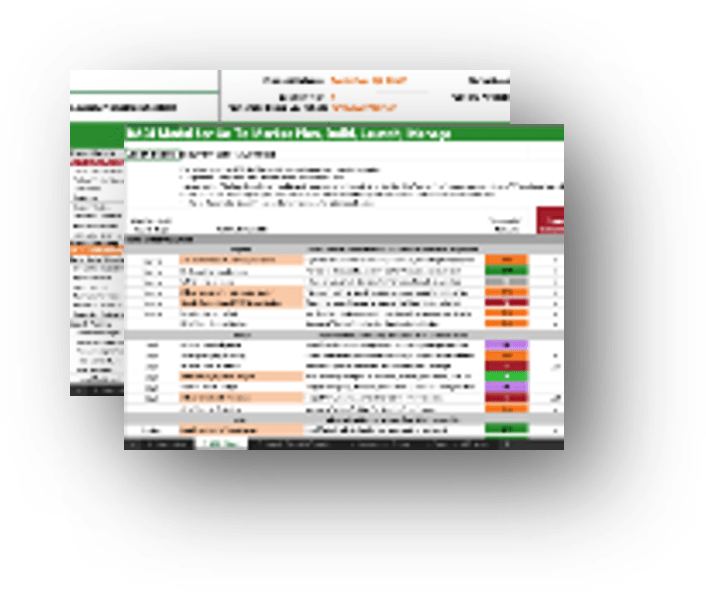
|
Go-to-Market Strategy Cost Budget and Revenue Forecast WorkbookCapture launch incremental costs that, when weighed against the forecasted revenue, illustrate gross margins as a crucial part of the business case. |
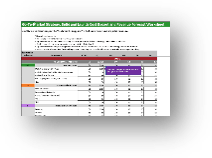
|
Product Market Opportunity SizingWhile not a deliverable of this blueprint per se, the Product Market Opportunity blueprint is required. |
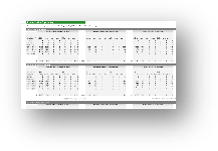
|
This blueprint calls for downloading the following additional blueprint: | ||
Buyer Persona and Journey blueprintWhile not a deliverable of this blueprint per se, the Buyer Persona and Journey blueprint is required |

|
|||
Info-Tech offers various levels of support to best suit your needs
DIY Toolkit |
Guided Implementation |
Workshop |
Consulting |
| "Our team has already made this critical project a priority, and we have the time and capability, but some guidance along the way would be helpful." | "Our team knows that we need to fix a process, but we need assistance to determine where to focus. Some check-ins along the way would help keep us on track." | "We need to hit the ground running and get this project kicked off immediately. Our team has the ability to take this over once we get a framework and strategy in place." | "Our team does not have the time or the knowledge to take this project on. We need assistance through the entirety of this project." |
| Included within advisory membership | Optional add-ons | ||
Guided Implementation
A Guided Implementation (GI) is a series of calls with a SoftwareReviews Advisory analyst to help implement our best practices in your organization.
For guidance on marketing applications, we can arrange a discussion with an Info-Tech analyst.
Your engagement managers will work with you to schedule analyst calls.
What does our GI on Build a More Effective Go-to-Market Strategy look like?
Build baseline market, buyer, and competitive insights |
Design initial product and business case |
Align stakeholder plans to prep for build |
| Call #1: Share GTM vision and outline team activities for the GTM Strategy process. Plan next call – 1 week.
Call #2: Outline product market opportunity approach and steps to complete. Plan next call – 1 week. Call #3: Hold a series of inquiries to do a modernization check on tech stack. Plan next call – 2 weeks. Call #4: Discuss buyer interview process, persona, and journey steps. Plan next call – 2 weeks. Call #5: Outline competitive differentiation analysis, routes to market, and review of to-date business case. Plan next call – 1 week. |
Call #6: Discuss brand strength/weakness, pricing, and packaging approach. Plan next call – 3 weeks.
Call #7: Outline needs to craft assets with right messaging across campaign launch plan and budget. Outline needs to create plans and budgets across rest of marketing, sales, CX, and product. Plan next call – 1 week. Call #8: Review template and approach for initial business case and sales and product alignment. Plan next call – 1 week. Call #9: Review initial business case and launch plans across marketing, sales, CX, and product. Plan next call – 1 week. |
Call #10: Discuss plans/needs/budgets for tech stack modernization. Plan next call – 3 days.
Call #11: Discuss plans/needs/budgets for CX readiness for launch. Plan next call – 3 days. Call #12: Discuss plans/needs/budgets for digital readiness for launch. Plan next call – 3 days. Call #13: Discuss plans/needs/budgets for marketing and sales readiness for launch. Plan next call – 3 days. Call #14: Review final business case and coach on Steering Committee Presentation. Plan next call – 1 week. |
A Go-to-Market Workshop Overview |
Contact your engagement manager for more information. |
| Day 1 | Day 2 | Day 3 | Day 4 | Day 5 | |
Align on GTM Vision & Plan, Craft Initial Strategy |
Identify Initial Business Case, Sales Forecast and Launch Plan |
Develop Launch Plans (i of ii) |
Develop Launch Plans (ii of ii) |
Present Final Business Case to Steering Committee |
|
| Activities |
1.1 Outline a vision for GTM and roles required, identify Steering Committee lead, workstream leads, and teams. 1.2 Capture GTM strategy hypothesis by working through initial draft of GTM Strategy Presentation and business case. 1.3 Capture team knowledge on buyer persona and journey and competitive SWOT. 1.4 Identify information/data gaps and sources and plan for capturing/gathering including buyer interviews. Plan next day 2-3 weeks after buyer persona/journey interviews. |
2.1 Size product market opportunity and initial revenue forecast. 2.2 Craft initial product hypothesis from buyer interviews including feature priorities, pricing, packaging, competitive differentiation, and channel/route to market. 2.3 Craft initial launch campaign, product release, sales, and CX readiness plans. 2.4 Identify launch budgets across each investment area. 2.5 Discuss initial product launch business case and key activities. Plan next day 2-3 weeks after product hypothesis-validation interviews with customers and prospects. |
3.1 Apply product interviews to scope, MVP, and roadmap competitive differentiation, pricing, feature prioritization, routes to market and sales forecast. 3.2 Develop more detailed launch campaign plan complete with asset-types, messaging, digital plan to support buyer journey, media buy plan and campaign metrics. |
4.1 Develop detailed launch/readiness plans with final budgets for:
|
5.1 Review final launch/readiness plans with final budgets for all key areas. 5.2 Move all key findings up into Steering Committee presentation slides. 5.3 Present to Steering Committee, receive feedback. 5.4 incorporate Steering Committee feedback; update finial business case. |
| Deliverables |
|
|
|
|
|
Build a More Effective Go-to-Market Strategy
Phase 1
Build baseline market, buyer, and competitive insights
| Phase 1
1.1 Select Steering Cmte/team, build aligned vision for GTM 1.2 Buyer personas, journey, initial messaging 1.3 Build initial product hypothesis 1.4 Size market opportunity 1.5 Outline digital/tech requirements 1.6 Competitive SWOT 1.7 Select routes to market 1.8 Craft GTM Strategy deck |
Phase 2
2.1 Brand consistency check 2.2 Formulate packaging and pricing 2.3 Craft buyer-valid product concept 2.4 Build campaign plan and targets 2.5 Develop cost budgets across all areas 2.6 Draft product business case 2.7 Update GTM Strategy deck |
Phase 3
3.1 Assess tech/tools support for all GTM phases 3.2 Outline sales enablement and Customer Success plan 3.3 Build awareness plan 3.4 Finalize business case 3.5 Final GTM Plan deck |
This phase will walk you through the following activities:
- Steering Committee and Team formulation
- A vision for go-to-market strategy
- Initial product hypothesis
- Market Opportunity sizing
- Tech stack/digital requirements
- Buyer persona and journey
- Competitive gaps, parity, differentiators
- Routes to market
- GTM Strategy deck
This phase involves the following stakeholders:
- Steering Committee
- Working group leaders
To complete this phase, you will need:
| Go-to-Market Strategy Presentation Template | Go-to-Market Strategy RACI and Launch Checklist Workbook | Buyer Persona and Journey blueprint | Product Market Opportunity Sizing Workbook |
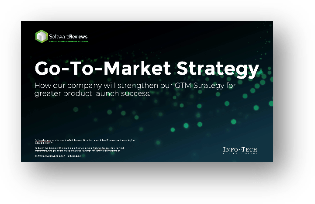
|
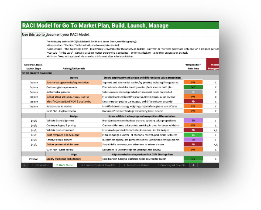
|
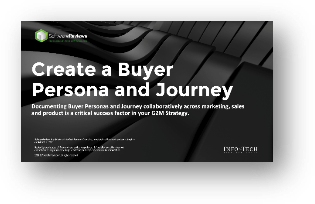
|
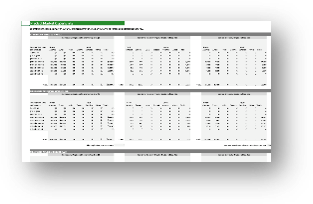
|
Use the Go-to-Market Strategy Presentation Template to document the results from the following activities:
|
Use the Go-to-Market Strategy RACI and Launch Checklist Workbook to:
|
Use the Buyer Persona and Journey blueprint to:
|
Use the Product Market Opportunity Sizing blueprint to:
|
Step 1.1
Identify a GTM Program Steering Committee and Team. Build an Aligned Vision for Your Go-to-Market Strategy Approach
Activities
- 1.1.1 Identify the Steering Committee of key stakeholders whose support will be critical to success
- 1.1.2 Select your go-to-market strategy program team
- 1.1.3 Discuss an overview of the GTM process and program roles and responsibilities with stakeholders and GTM workstream leads
- 1.1.4 Develop a Go-to-Market launch, tiering, time-line, and overall program plan
- 1.1.5 Work with each workstream lead on their overall project plan and incremental budget requirements
This step will walk you through the following activities:
- Identify stakeholders – your Steering Committee
- Identify team members
- Present a vision of GTM Strategy
This step involves the following participants:
- Steering Committee
- Program workstream leads
Outcomes of this step
- Steering Committee identified
- Team members identified
- All aligned on the GTM process
- Go-to-market strategy timeline and program plan
| Step 1.1 | Step 1.2 | Step 1.3 | Step 1.4 | Step 1.5 | Step 1.6 | Step 1.7 | Step 1.8 |
1.1.1 Identify stakeholders critical to success
1-2 hoursInput: Steering Committee interviews, Recognition of Steering Committee interest
Output: List of GTM Strategy stakeholders as Steering Committee members
Materials: Following slide outlining the key responsibilities required of the Steering Committee members, A high-Level timeline of GTM Strategy phases and key milestone meetings
Participants: CMO, sponsoring executive, Functional leads - Marketing, Product Marketing, Product Management, Sales, Customer Success
- The GTM Strategy initiative manager should meet with the CMO to determine who will comprise the Steering Committee for your GTM Strategy.
- Finalize selection of steering committee members.
- Meet with members to outline their roles and responsibilities and ensure their willingness to participate.
- Document the steering committee members and the milestone/presentation expectations for reporting project progress and results.
SoftwareReviews Advisory Insight:
Go To Market Steering Committee’s can become an important ongoing body to steer overall product, pricing and other GTM decisions. Some companies have done so by adding the CEO and CFO to this committee and designated it as a permanent body that meets monthly to give go/no decisions to “all things product related” across all products and business units. Leaders that use this tool well, stay aligned, demonstrate consistency across business units and leverage outcomes across business units to drive greater scale.
Go-to-Market Strategy Stakeholders
Understand that aligning key stakeholders around the way your company goes to market is an essential company function.
| Title | Key Roles Supporting an Effective Go-to-Market Strategy |
| Go-to-Market Strategy Sponsor |
|
| Go-to-Market Strategy Program Manager |
|
| Functional Workstream Leads |
|
| Digital, Marketing/Sales Ops/IT Team |
|
| Steering Committee |
|
Download the Go-to-Market Strategy Presentation Template
Roles vary by company size. Launch success depends on clear responsibilities
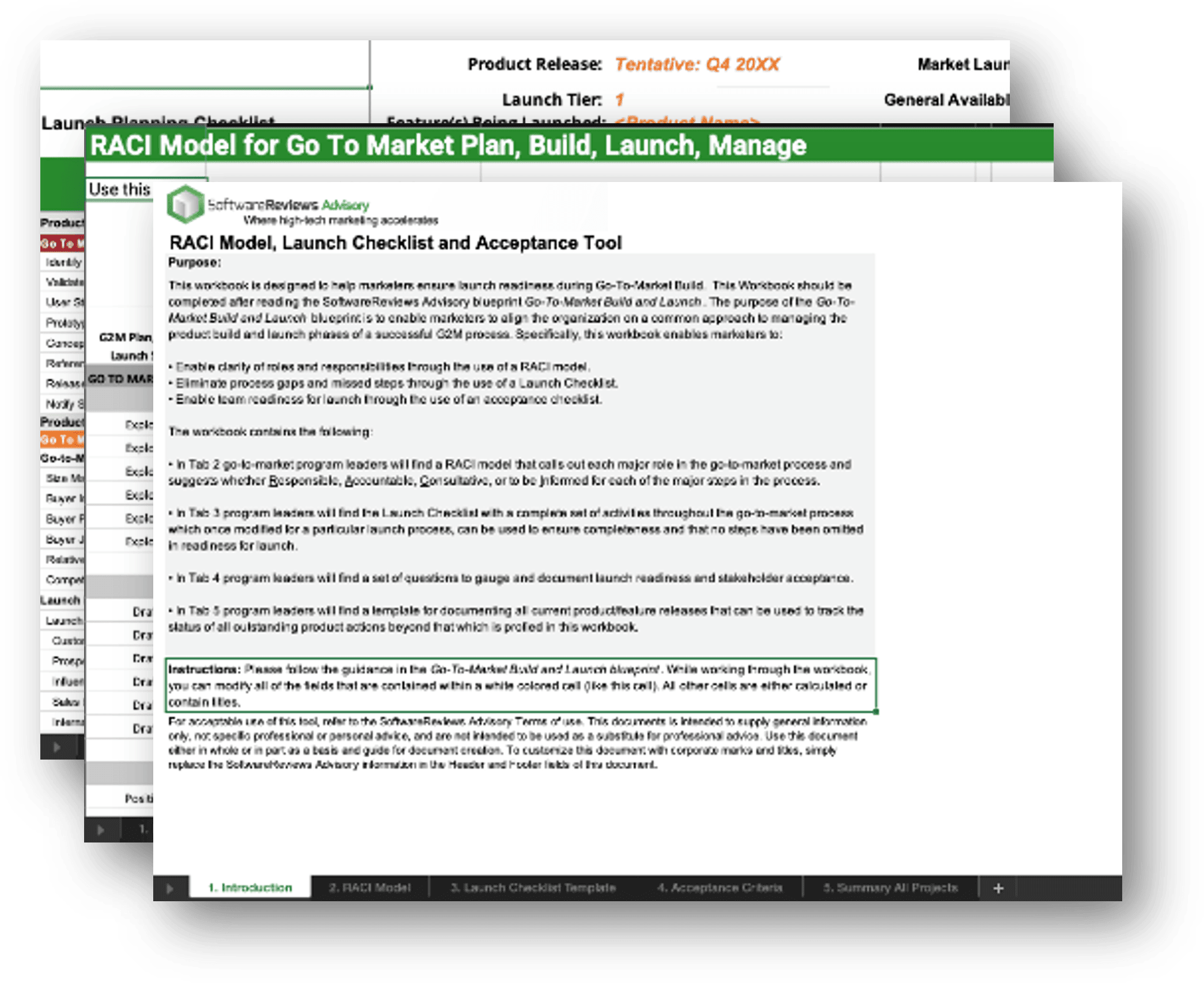
Download the Go-to-Market Strategy RACI and Launch Checklist Workbook |
Success improves when you align & assign
|
Go-to-Market Strategy Working Team
Consider the skills and knowledge required for GTM Strategy as well as build and launch functions when choosing teams.
Work with functional leaders to select workstream leads
Workstream leads should be strong in collaboration, coordination of effort among others, knowledgeable about their respective function, and highly organized as they may be managing a team of colleagues within their function to deliver their responsible portion of GTM.
Required Skills/Knowledge
|
Suggested Functions
|
| Roles Required in Successful GTM Strategy | |
| For SMB companies, as employees wear many different hats, assign people that have the requisite skills and knowledge vs. the role title. | 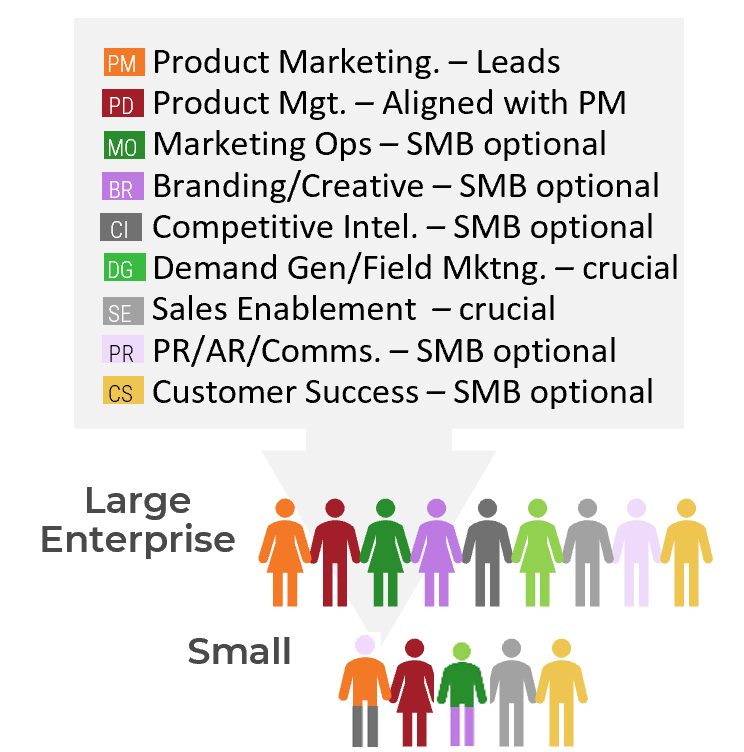
|
Download the Go-to-Market Strategy RACI and Launch Checklist Workbook
1.1.2 Select the GTM Strategy working team
1-2 hoursInput: Stakeholders and leaders across the various functions outlined to the left
Output: List of go-to-market strategy team members
Materials: Go-to-Market Strategy Workbook
Participants: Initiative Manager, CMO, Sponsoring executive, Departmental Leads – Sales, Marketing, Product Marketing, Product Management (and others), Marketing Applications Director, Senior Digital Business Analyst
- The GTM Strategy Initiative Manager should meet with the GTM Strategy Sponsor and functional leaders of workstream areas/functions to determine which team members will serve as Steering Committee members and who will serve as workstream leads.
- The working team for your go-to-market strategy should have the following roles represented in the working team:
- Depending on the initiative and the size of the organization, the team will vary.
- Key business leaders in key areas – Product Marketing, Field Marketing, Digital Marketing, Inside Sales, Sales, Marketing Ops., Product Management, and IT – should be involved.
- Document the members of your go-to-market strategy team in the Go-to-Market Strategy Presentation slide entitled “Our Team.”
Download the Go-To-Market Strategy RACI and Launch Checklist Workbook
1.1.3 Develop a timeline for key milestones
1 hour
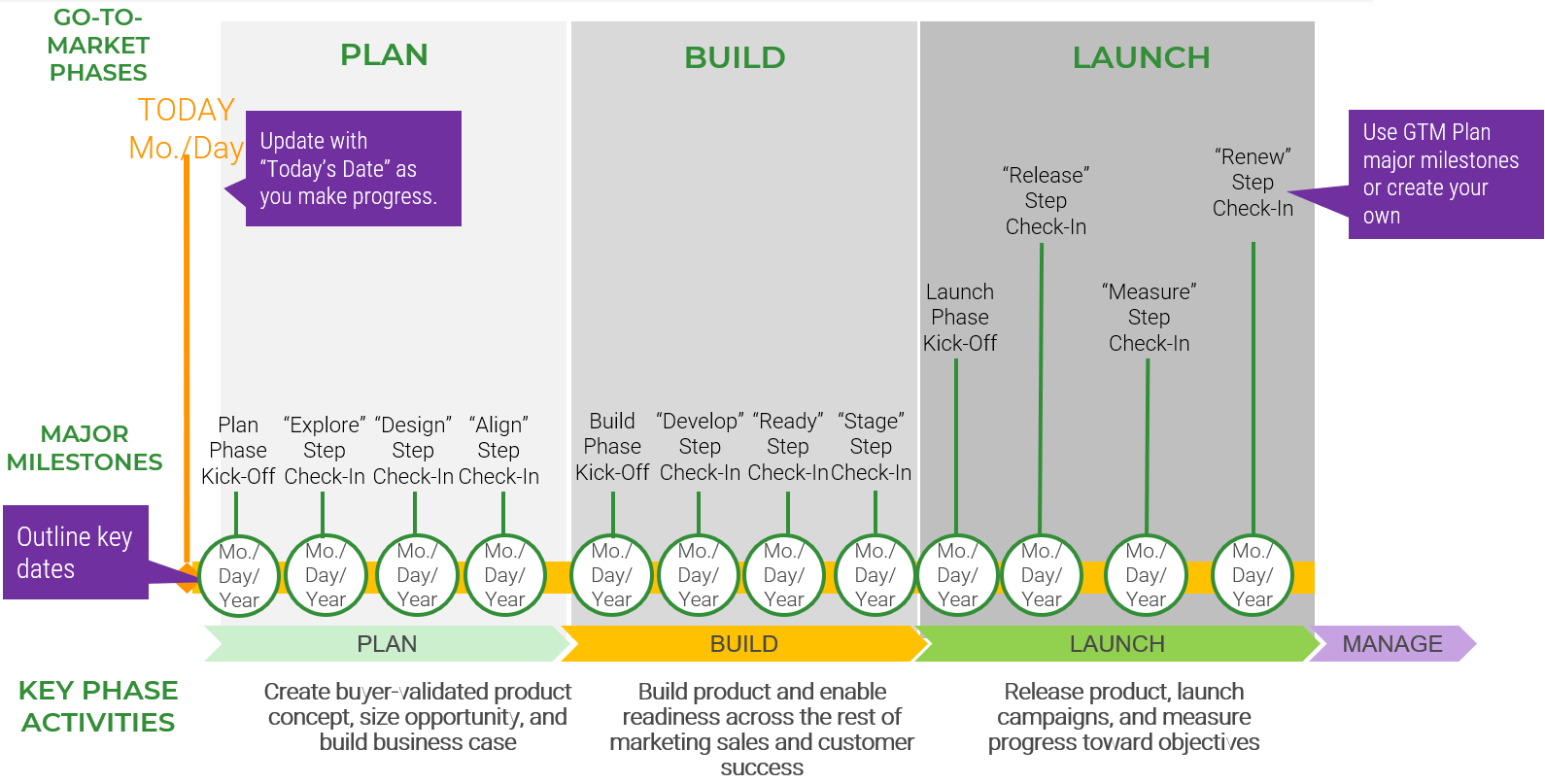
GTM Program Managers:
- Will establish key program milestones working collaboratively with the Steering Cmte. and workstream leads.
- Outline key ”Market-facing” or external deliverables & dates, as well as internal.
- More detailed deliverable plans are called for working with workstream leads.
- This high-level overview will be used in regular Steering Cmte. and working team meets
- Record in the Go-to-Market Strategy Presentation
Download the Go-to-Market Strategy Presentation Template
1.1.5 Share your GTM strategy vision with your team
1-2 hoursInput: N/A
Output: Team understanding of an effective go-to-market strategy, team roles and responsibilities and initial product and launch concept.
Materials: The Build a More Effective Go-to-Market Strategy Executive Brief
Participants: GTM Program Manager, CMO, Sponsoring executive, Workstream leads
- Download the Build a More Effective Go-to-Market Strategy Executive Brief and add the additional slides on Team Composition and Key Milestones you have created in prior steps as appropriate.
- Convene the Steering Committee and Working Team and take them through the Build a More Effective Go-to-Market Strategy Executive Brief with your additional slides to:
- Communicate team composition, roles and responsibilities, and key GTM Strategy program milestones.
- Educate them on what comprises a complete GTM Strategy from the Executive Brief.
- Optional: As a SoftwareReviews Advisory client, invite a SoftwareReviews analyst to present the Executive Brief if that is of help to you and your team.
Go to the Build a More Effective Go-to-Market Strategy Executive Brief
GTM program managers and workstream leads will collaborate on detailed project plans
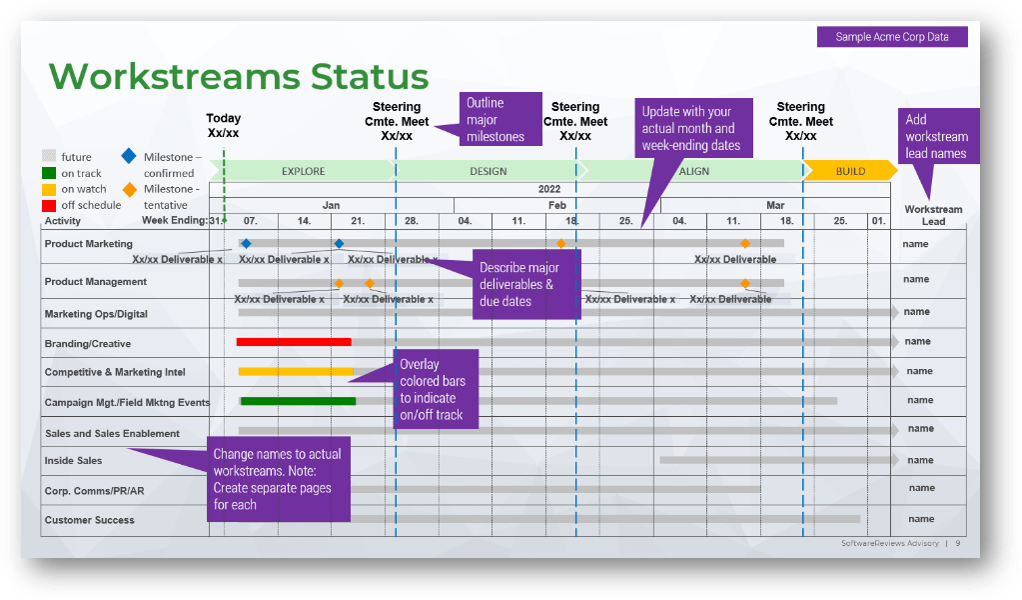
Program managers will:
- Outline an overall more detailed way of tracking GTM program workstreams, key dates and on/off track status
Program managers & workstream leads will:
- Call out each key workstream and workstream lead
- Outline key deliverables and due dates
- Track weekly for communicating status to Steering Cmte and working team meetings
Use the Launch Checklist when building out full project plans
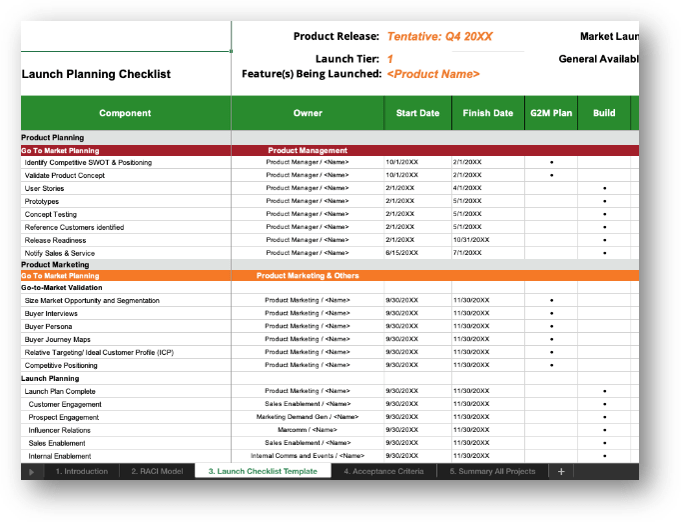 Download the Go-to-Market Strategy RACI and Launch Checklist Workbook | Continuous improvement is enabled with a repeatable process
|
1.1.6 Develop a project plan for each workstream
Work with your workstream leads to see them develop a detailed project plan that spans all their deliverables for a GTM Strategy
|
Using the Go-to-Market Strategy Presentation:
3-4 hours Initial, 1-2 hours weekly
|
Download the Go-to-Market Strategy Presentation Template
Download the Go-To-Market Strategy RACI and Launch Checklist Workbook
Step 1.2
Hold Interviews With Sales Then Customers and Prospects to Inform Your Initial Product Concept
Activities
- 1.2.1 Use the SoftwareReviews Buyer Persona and Journey Interview Guide and Data Capture Tool found within the SoftwareReviews Buyer Persona and Journey blueprint.
- 1.2.2 Follow the instructions within the above blueprint and hold interviews with Sales and customers and prospects to inform your buyer persona, initial product hypothesis, and buyer journey.
- 1.2.3 Flush out the initial product and launch concept using the slides found within the Go-to-Market Strategy Presentation Template. You will continually refine the Go-to-Market Strategy Presentation Template such that you turn the Product and Launch descriptions into a business case for product build and launch. We advise you and your team to populate the slides to begin to inform an initial concept, then hold interviews with Sales, customers, and prospects to refine. The best way to capture customer and prospect insights is to use the Buyer Persona and Journey blueprint.
This step will walk you through the following activities:
- Schedule time with sales/sales advisory to flush out the product concept
- Develop your customer and prospect interviewee list
- Consolidate findings for your GTM Strategy program slide deck
This step involves the following participants:
- Sales/sales advisory, product management, initiative leader (product marketing)
- Customers and prospects
Outcomes of this step
- Guidance from sales on product concept
- Initial guidance from customers and prospective buyers
- Agreement to proceed further
Phase 1 - Formulate a hypothesis and run discovery on key fundamentals
| Step 1.1 | Step 1.2 | Step 1.3 | Step 1.4 | Step 1.5 | Step 1.6 | Step 1.7 | Step 1.8 |
Documenting buyer personas enables success beyond marketing
Documenting buyer personas has several essential benefits to marketing, sales, and product teams:
|
“It’s easier buying gifts for your best friend or partner than it is for a stranger, right? You know their likes and dislikes, you know the kind of gifts they’ll have use for, or the kinds of gifts they’ll get a kick out of. Customer personas work the same way. By knowing what your customer wants and needs, you can present them with content targeted specifically to those wants and needs.” (Emma Bilardi, Product Marketing Alliance, July 8, 2020) |
Buyer persona attributes that need defining
A well defined buyer persona enables us to:
- Clarify target org-types, identify buying decision makers and key personas, and determine how they make decisions
- Align colleagues around a common definition of target buyer(s) to drive improvements in messaging and engagement across marketing, sales, and customer success
- Identify specific asset-types and tools that, when activated within our lead gen engine and in the hands of sellers, helps a buyer move through a decision process
| Functional – “to find them” | ||||
| Job Role | Titles | Org Chart Dynamics | Buying Center | Firmographics |
| Emotive – “what they do and jobs to be done” | |||
| Initiatives – What programs/projects the persona is tasked with and what are their feelings and aspirations about these initiatives? Motivations? Build credibility? Get promoted? | Challenges – Identify the business issues, problems, and pain points, that impede attainment of objectives. What are their fears, uncertainties, and doubts about these challenges? | Buyer need – They may have multiple needs; which need is most likely met with the offering? | Terminology – What are the keywords/phrases they organically use to discuss the buyer need or business issue? |
| Decision Criteria – “how they decide” | |
| Buyer role – List decision-making criteria and power level. The five common buyer roles are champion, influencer, decision maker, user, and ratifier (purchaser/negotiator). | Evaluation and decision criteria – The lens, either strategic, financial, or operational, through which the persona evaluates the impact of purchase. |
| Solution Attributes – “what the ideal solution looks like” | ||||||
| Steps in “Jobs to be Done” | Elements of the “Ideal Solution” | Business outcomes from ideal solution | Opportunity scope – other potential users | Acceptable price for value delivered | Alternatives that see consideration | Solution sourcing – channel, where to buy |
| Behavioral Attributes – “how to approach them successfully” | ||
| Content preferences – List the persona’s content preferences, could be blog, infographic, demo, video, or other, vs. long-form assets (e.g. white paper, presentation, analyst report). | Interaction preferences – Which among in-person meetings, phone calls, emails, video conferencing, conducting research via web, mobile, and social. | Watering holes – Which physical or virtual places do they go to network or exchange info with peers e.g. LinkedIn, etc. |
Buyer journeys are constantly shifting
If you haven’t re-mapped buyer journeys recently, you may be losing to competitors that have. Leaders re-map buyer journeys frequently.
SoftwareReviews Advisory Insight:
|
“Two out of three B2B buyers today prefer remote human interactions or digital self service.
And during August 2020-February 2021, use of digital self service leapt by 10%” (McKinsey & Company, 2021.) |
Challenges of not mapping persona and journey
A lack of buyer persona and journey understanding is frequently the root cause of the following symptoms:
These challenges are often attributed to messaging and talk tracks that fail to resonate with prospects and products that fail to meet the needs of targeted buyers. SoftwareReviews Advisory Insight:
|
“Forty-four percent of B2B marketers have already discovered the power of personas.” (Boardview, 2016.) |
1.2.1 Interview Sales and customers/prospects
12 - 15 Hours, over course of 2-3 weeks
Input: Insights from Sellers, Insights from customers and prospects
Output: Completed slides outlining buyer persona, buyer journey, overall product concept, and detailed features and capabilities needed
Materials: Create a Buyer Persona and Journey blueprint, Go-to-Market Strategy Presentation
Participants: Product management lead, GTM Program Manager, Select sellers, Workstream leads that wish to participate in interviews
- Using the Create a Buyer Journey and Persona Journey blueprint:
- Follow the instructions to interview a group of Sellers, and most importantly, several customers and prospects
- For this stage in the GTM Strategy process, the goal is to validate your initial product and launch concept.
- We urge getting through all the interview questions with interviewees as the answers inform:
- Product market fit and Minimal Viable Product
- Competitive differentiation
- Messaging, positioning, and campaign targeting
- Launch campaign asset creation.
- Place summary findings into the Go-to-Market Strategy Presentation, and for reference, place the Buyer Persona and Journey Summaries into the Go-to-Market Strategy Presentation Appendix.
- Follow the instructions to interview a group of Sellers, and most importantly, several customers and prospects
Download the Go-to-Market Strategy Presentation Template
Download the Create a Buyer Journey and Persona Journey blueprint
Step 1.3
Update Your Product Concept
Activities
- 1.3.1 Based on Sales and Customer/Prospect interviews, update:
- Your product concept slide
- Detailed prioritization of features and capabilities
This step calls for the following activities:
- Update the product concept slide based on interview findings
- Update/create the stack-ranking of buyer requested feature and capability priorities
This step involves the following participants:
- Product management lead
- GTM initiative leader
- Select workstream leads who sat in on interview findings
Outcomes of this step
- Advanced product concept
- Prioritized features for development during Build phase
- Understanding of MVP to deliver customer value and deal “wins”
Phase 1 - Formulate a hypothesis and run discovery on key fundamentals
| Step 1.1 | Step 1.2 | Step 1.3 | Step 1.4 | Step 1.5 | Step 1.6 | Step 1.7 | Step 1.8 |
1.3.1 Update Product and Launch concept
2 Hours
Input: Insights from Sellers, Insights from customers and prospects
Output: Completed slides outlining product concept and detailed features and capabilities needed
Materials: Go-to-Market Strategy Presentation
Participants: Product management lead, GTM Program Manager, Select sellers, Workstream leads that wish to participate in interviews
- Using the Go-to-Market Strategy Presentation:
- With interview findings, update the Product and Launch Concept, Buyer Journey, and Capture Key Features/Capabilities of High Importance to Buyers slides
Download the Go-to-Market Strategy Presentation Template
Product and Launch Concept
At this early stage, summarize findings from concept interviews to guide further discovery, as well as go-to-market concepts and initial campaign concepts in upcoming steps.
Job Function AttributesTarget Persona(s):
Firmographics:
|
Emotive AttributesInitiative descriptions: Buyer description of project/program/initiative. What terms used? Business issues: What are the business issues related to this initiative? How is this linked to a CEO-level mission-critical priority? Key challenges: What business/process hurdles need to be overcome? Pain points: What are the pain points to the business/personally in their role related to the challenges that drove them to seek a solution? Success motivations: What motivates our persona to be successful in this area? |
Solution and OpportunitySteps to do the job: What are the needed steps to do this job today? Key features and capabilities: What are the key solution elements the buyer sees in the ideal solution? (See additional detail slide with prioritized features.) Key business outcomes: In business terms, what value (e.g. cost/time/FTE savings, deals won, smarter, etc.) is expected by implementing this solution? Other users/opportunities: Are there other users in the role team/company that would benefit from this solution? |
Pricing/PackagingWhat is an acceptable price to pay for this solution? Based on financial benefits and ROI hurdles, what’s a good price to pay? A high price? What are packaging options? Any competitive pricing to compare? |
Alternatives/CompetitionWhat are alternatives to this solution: How else would you solve this problem? Are there other solutions you’ve investigated? |
Channel PreferencesWhere would it be most convenient to buy?: Direct from provider? Channel partner/reseller? Download from the web? |
Decision Criteria AttributesDecision maker – Role, criteria/decision lens:
|
Behavioral AttributesInteraction preferences: Best way for us to reach this role? Email? At events? Texting? Video calls? Content types: Which content types (specifics; videos, short blog/article, longer whitepapers, etc.) help us stay educated about this initiative area? Content sources: What news, data, and insight sources (e.g. specifics) do you use to stay abreast of what’s important for this initiative area? |
Update the Go-to-Market Strategy Presentation with findings from Sales and customer/prospect interviews.
Capture key features/capabilities of high importance to buyers
Ask buyers during interviews, as outlined in the Buyer Persona and Journey blueprint, to describe and rate key features by need. You will also review with buyers during the GTM Build phase, so it’s important to establish high priority features now.
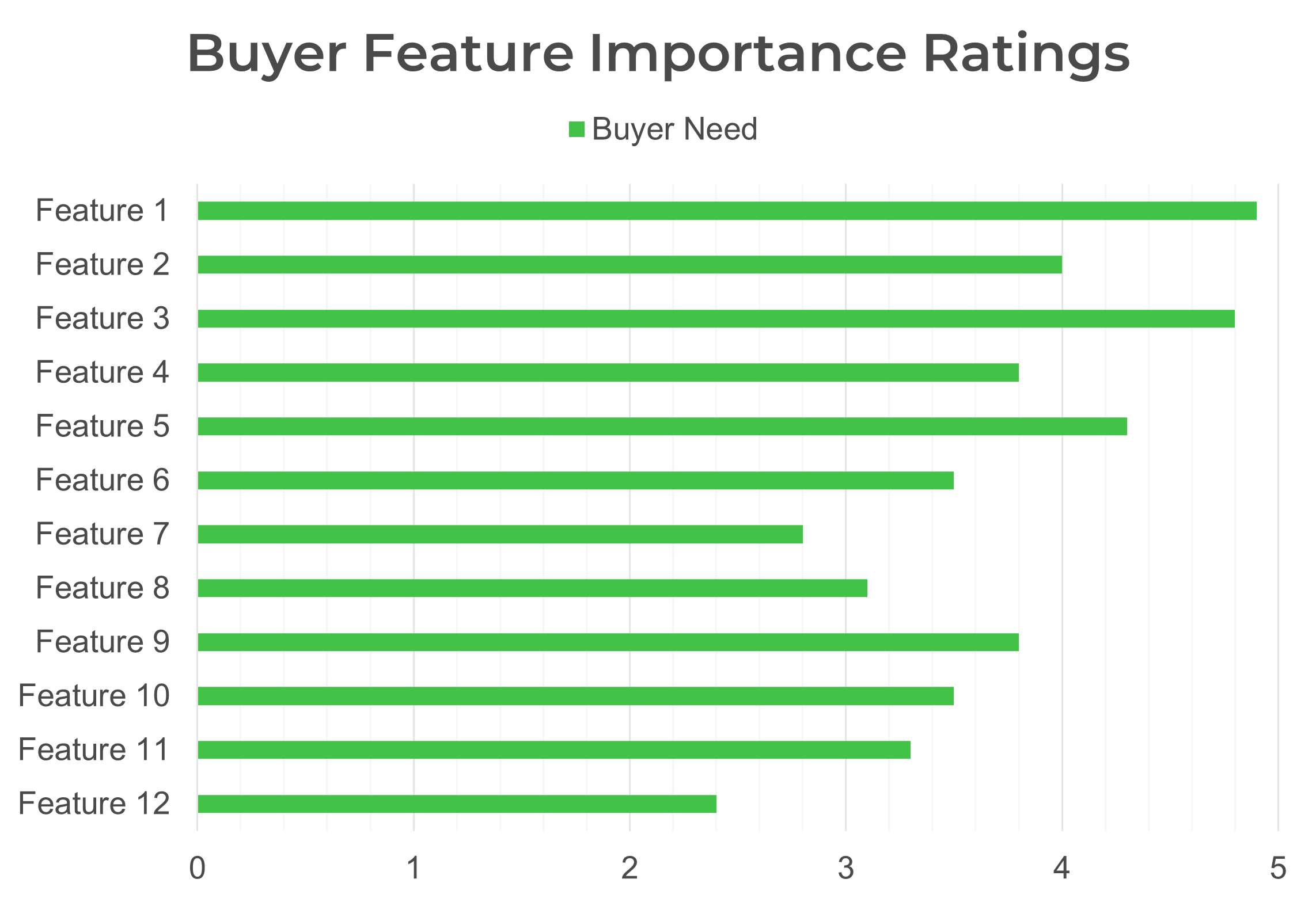
|
|
- Ease of use, security, availability of training, service model, etc. – and other “non-feature” areas that you need for your product hypothesis.
Step 1.4
Size the Product Market Opportunity
Activities
- 1.3.1 Based on the product concept, size, and the product market opportunity and with a focus on your “Obtainable Market”:
- Clarify the definitions used to size market opportunity.
- Source data both internally and externally.
- Calculate the available, obtainable market for your software product.
This step will walk you through the following activities:
- Review market sizing definitions and identify required data
- Identify the target market for your software application
- Source market and internal data that will support your market sizing
- Document and validate with team members
This step involves the following participants:
- GTM initiative leader
- CMO, select workstream leads
Outcomes of this step
- Definitions on market sizing views
- Data sourcing established
- Market sizing and estimated penetration calculations
Phase 1 - Formulate a hypothesis and run discovery on key fundamentals
| Step 1.1 | Step 1.2 | Step 1.3 | Step 1.4 | Step 1.5 | Step 1.6 | Step 1.7 | Step 1.8 |
Market opportunity sizing definitions
Your goal is to assess whether or not the opportunity is significantly sized and if you are well positioned to capture it
- This exercise is designed to help size the market opportunity for this particular product GTM launch and not the market opportunity for the entire product line or company. First a few market sizes to define:
- Penetrated – is your current revenues and can be expressed in your percentage vs. competitors’.
- Serviceable Obtainable Market (SOM) – larger than your currently penetrated market, and a percentage of SAM that can realistically be achieved. It accounts for your current limitations to reach and your ability to sell to buyers. It is restricted by your go-to-market ability and reduced by competitive market share. SOM answers: What increased market can we obtain by further penetrating accounts within current geographical coverage and go-to-market abilities and within our ability to finance our growth?
- Serviceable Available Market (SAM) – larger than SOM yet smaller than TAM, SAM accounts for current products and current go-to-market capabilities and answers: What if every potential buyer bought the products we have today and via the type of go-to-market (GTM) especially geographical coverage, we have today? SAM calls for applying our current GTM into unpenetrated portions of currently covered customer segments and regions.
- Total Available Market (TAM) – larger than SAM, TAM sizes a market assuming we could penetrate other customer segments within currently covered regions without regard for resources, capabilities, or competition. It answers the question: If every potential buyer within our available market – covered regions – bought, how big would the market be?
- Total Global Market – estimates market opportunity if all orgs in all segments and regions bought – with full disregard for resources and without the restrictions of our current GTM abilities.
- Develop your market opportunity sizing using the Product Market Opportunity Sizing Workbook.
Download the Product Market Opportunity Sizing Workbook
SoftwareReviews Advisory Insight:
Product marketers that size the product market opportunity and account for the limitations posed by competitors, current sales coverage, brand permission, and awareness, provide their organizations with valuable insights into which inhibitors to growth should be addressed.
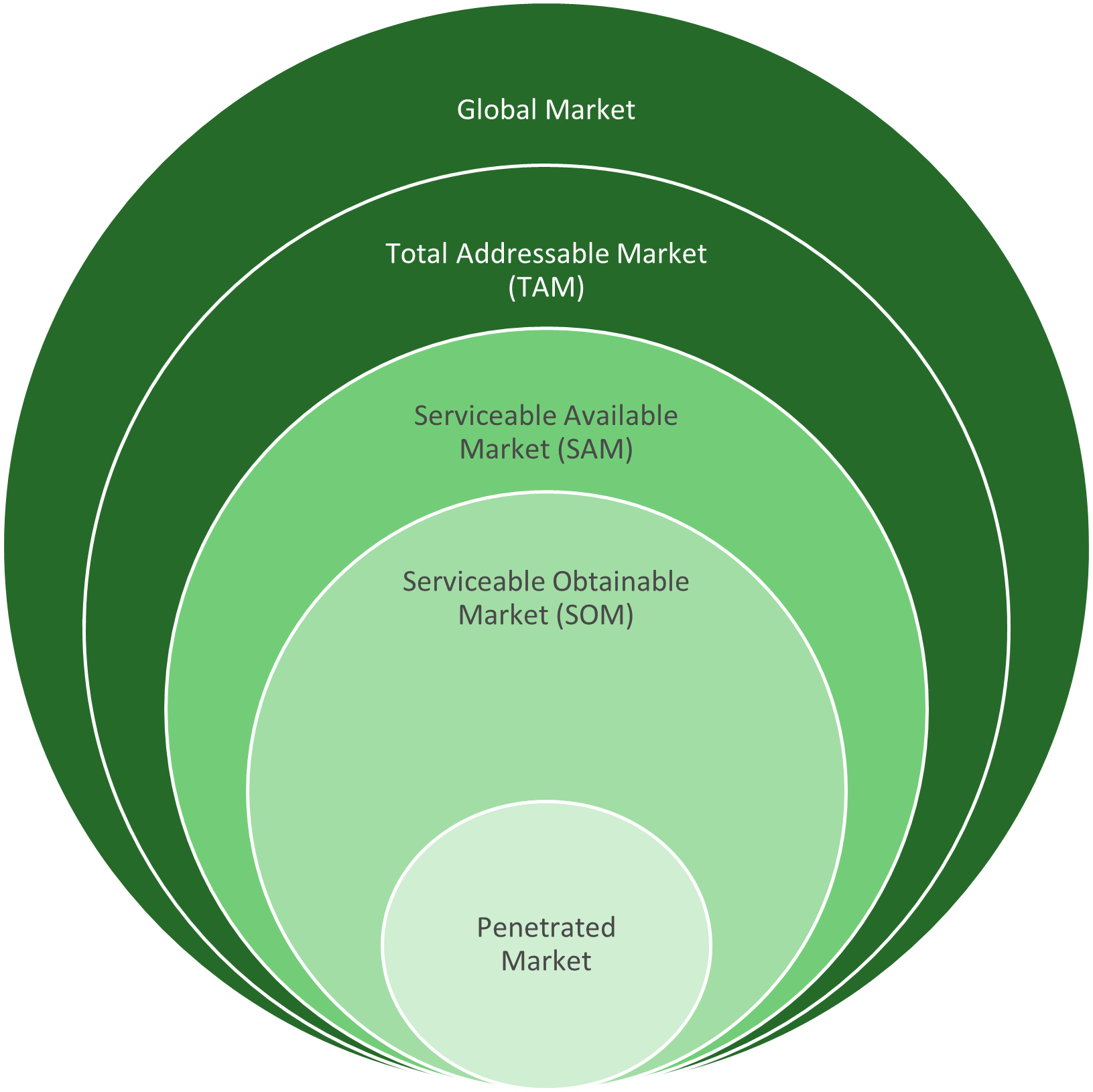
1.4.1 Size the product market opportunity
Your goal is two-fold: Determine the target market size, and develop a realistic 12–24 month forecast to support your business case
Download the Product Market Opportunity Sizing Workbook Download the Go-to-Market Strategy Presentation Template |
“Segmentation, targeting and positioning are the three pillars of modern marketing. Great segmentation is the bedrock for GTM success but is overlooked by so many.” (Product Marketing Alliance) |
Step 1.5
Outline Digital and Tech Requirements
Activities
Designing your go-to-market strategy does not require a robust customer experience management (CXM) platform, but implementing your strategy during the next steps of Go-to-Market – Build then Launch – certainly does.
Review info-Tech’s CXM blueprint to build a more complete, end-to-end customer interaction solution portfolio that encompasses CRM alongside other critical components.
The CXM blueprint also allows you to develop strategic requirements for CRM based on customer personas and external market analysis called for during your GTM Strategy design.
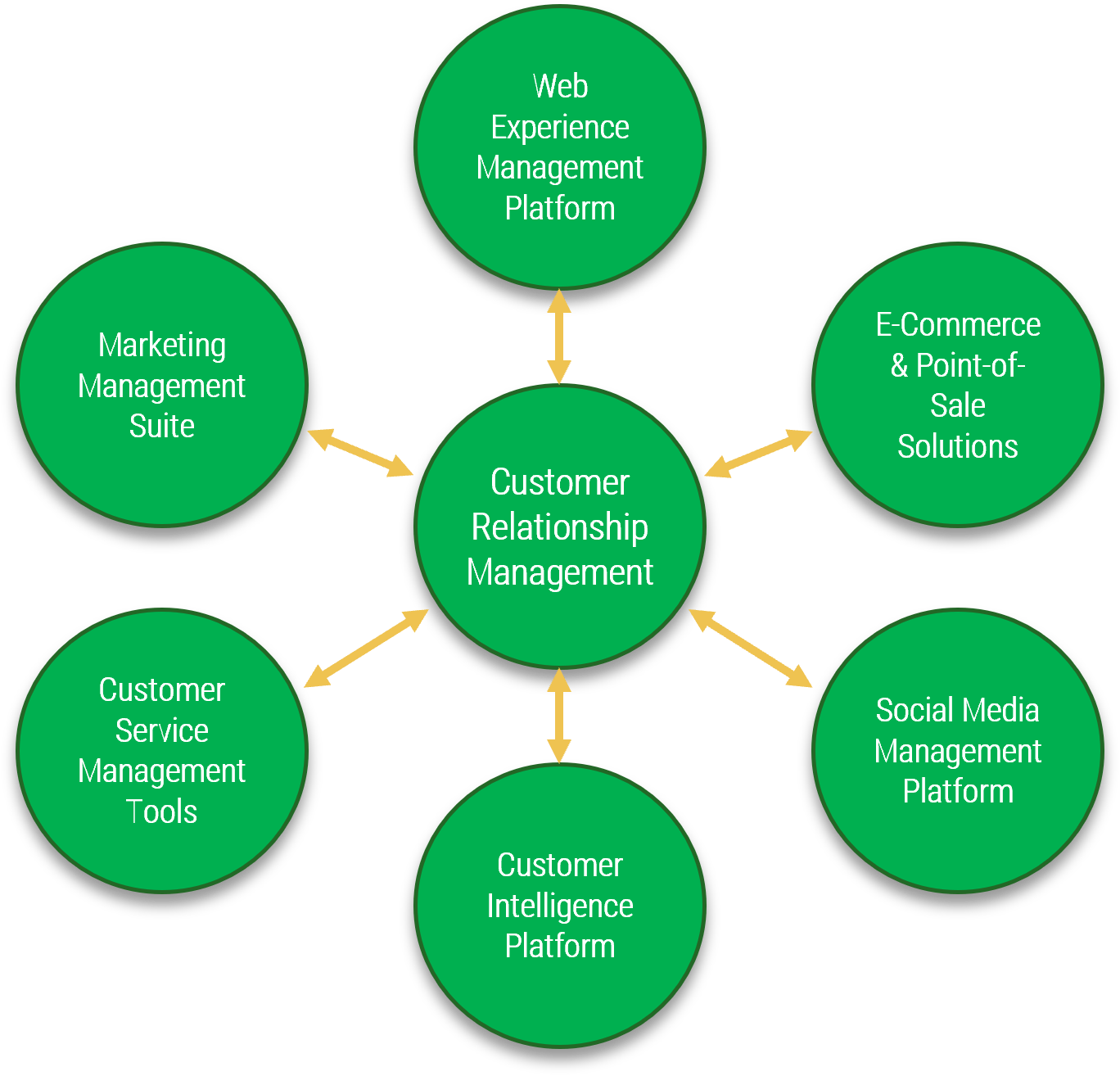
These steps outlined in the CXM blueprint, will help you:
- Assess your CRM application(s) and the environment in which they exist. Take a business-first strategy to prioritize optimization efforts.
- Validate CRM capabilities, user satisfaction, issues around data, vendor management, and costs to build out an optimization strategy
- Pull this all together to develop a prioritized optimization roadmap.
This step involves the following participants:
- Marketing Operations, Digital, IT
- Project workstream leads as appropriate
Outcomes of this step
- After inquiries with appropriate analysts, client will be able to assess what new application and technology support is required to support Go To Market process.
Phase 1 - Formulate a hypothesis and run discovery on key fundamentals
| Step 1.1 | Step 1.2 | Step 1.3 | Step 1.4 | Step 1.5 | Step 1.6 | Step 1.7 | Step 1.8 |
Step 1.6
Identify features and capabilities that will drive competitive differentiation
Activities
- 1.6.1 Hold a session with key stakeholders including sales, customer success, product, and product marketing to develop a hypothesis of features and capabilities vs. competitors: differentiators, parity areas, and gaps (DPG).
- Optional for clients with buyer reviews and key competitive reviews within target product category:
- 1.6.2 Request from SoftwareReviews a 2X2 Matrix Report of Importance vs. Satisfaction for both features and capabilities within your product market/category to identify areas of competitive DPG.
- 1.6.3 Hold an Inquiry with covering ITRG analysts in your product category to have them validate key areas of competitive DPG.
- 1.6.4 Document competitive DPG and build out your hypothesis for product build as you ready for customer interviews to validate that hypothesis.
This step will provide processes to help you:
- Understand and document competitive differentiation, parity, and gaps
This step involves the following participants:
- Project workstream leads in product marketing, competitive intelligence, product management, and customer success
Outcomes of this step
- Develop a clear understanding of what differentiated capabilities to promote, which parity items to mention in marketing, and which areas are competitive gaps
- Develop a hypothesis of what areas need to be developed during the Build phase of the Go-to-Market lifecycle
Phase 1 - Formulate a hypothesis and run discovery on key fundamentals
| Step 1.1 | Step 1.2 | Step 1.3 | Step 1.4 | Step 1.5 | Step 1.6 | Step 1.7 | Step 1.8 |
Assess current capabilities and competitive differentiation vs. buyer needs
Taking buyer needs ratings from step 1.3, assess your current and key competitive capabilities against buyer needs for both feature and non-feature capabilities. Incorporate into your initial product hypothesis.
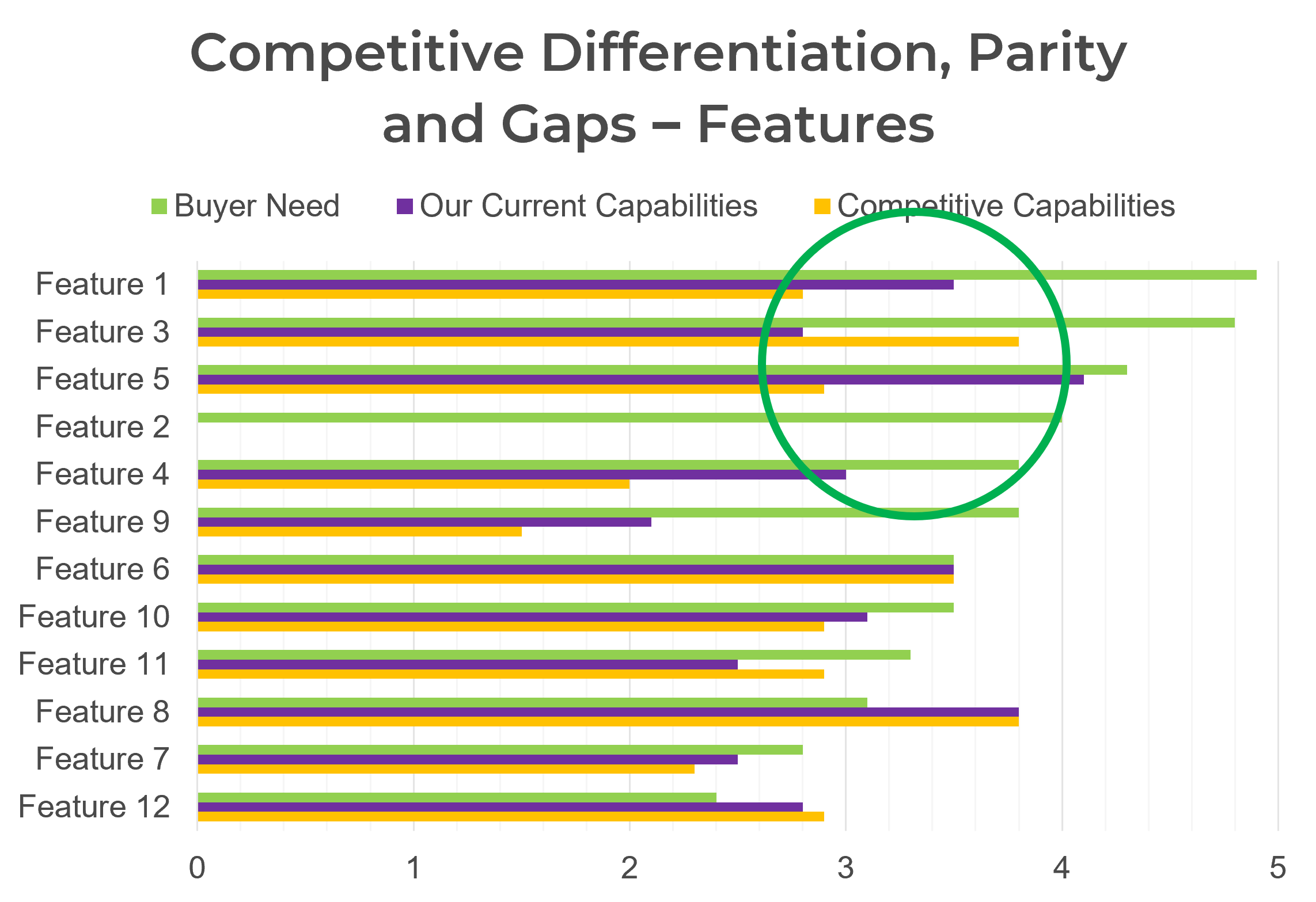
- Rank features in order of buyer need from step 1.3.
- Prioritize development needs where current capabilities are rated low. Spot areas for competitive differentiation especially in high buyer-need areas.
- ease of use
- security
- availability of training
- service model
Optional: Validate feature and capability importance with buyer reviews
Request from your SoftwareReviews Engagement Manager the “Importance vs. Satisfaction” analysis for your product(s) feature and non-feature capabilities under consideration for your GTM Strategy
| Satisfaction | ||
| Fix | Promote | |
| Importance |
Low Satisfaction
These features are important to their market and will highlight any differentiators to avoid market comparison.
|
High Satisfaction
These are real strengths for the organization and should be promoted as broadly as possible.
|
Low Satisfaction
These features are not important for the market and are unlikely to drive sales if marketing material focuses on them. Rationalize investment in these areas.
|
High Satisfaction
Features are relatively strong, so highlight that these features can meet customer needs
|
|
| Review | Maintain | |
Overall Category Product Feature Satisfaction Importance
- Importance is based on how strongly satisfaction for a feature of a software suite correlates to the overall Likeliness to Recommend
- Importance is relative – low scores do not necessarily indicate the product is not important, just that it’s not as important as other features
(Optional for clients with buyer reviews and key competitive reviews within target product category.)
Optional: Feature importance vs. satisfaction
Example: ERP “Vendor A” ratings and recommended key actions. Incorporate this analysis into your product concept if updating an existing solution. Have versions of the below run for specific competitors.
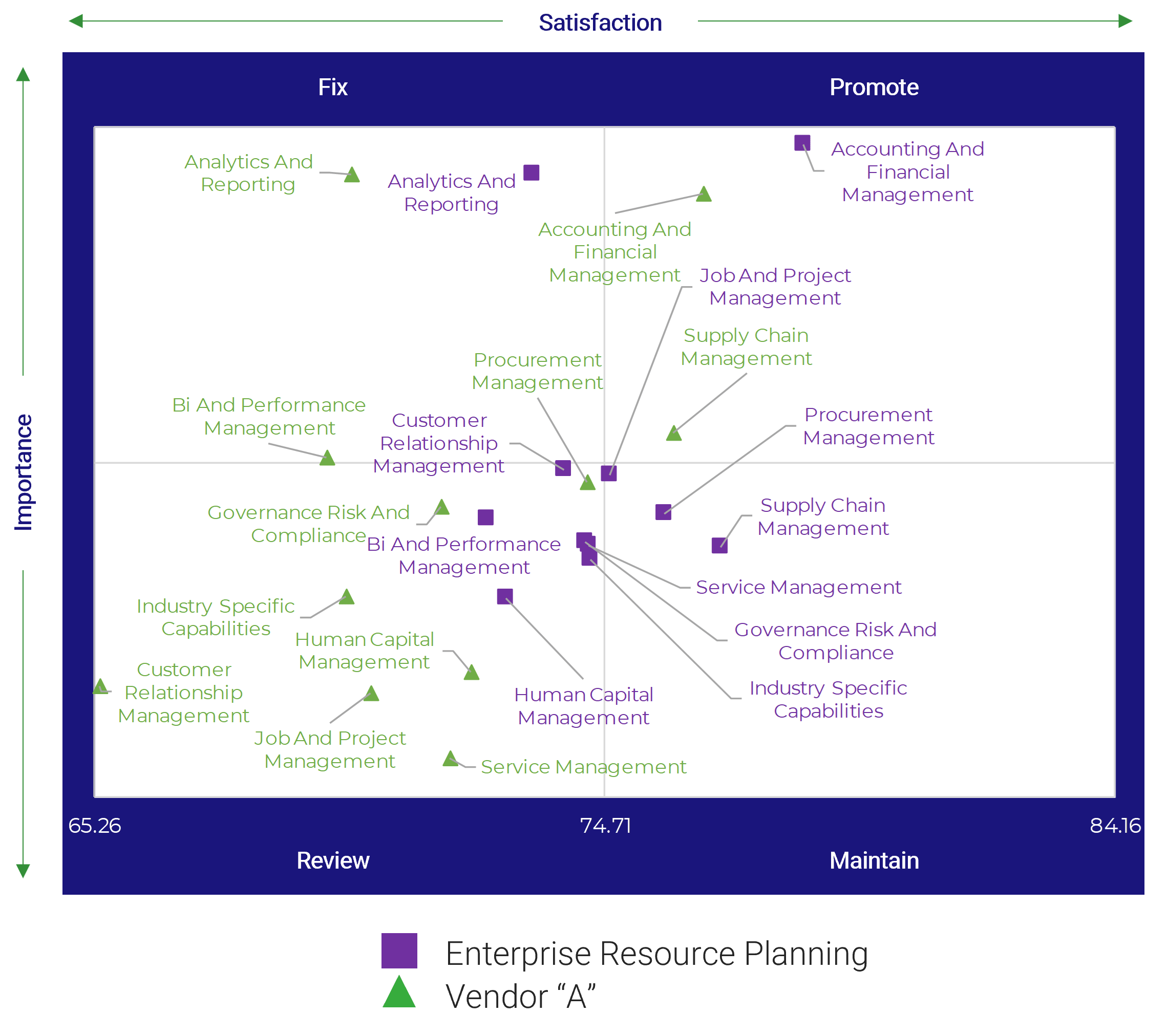
Features in the “Fix” quadrant should be addressed in this GTM Strategy cycle.
Features in the “Review” quadrant are low in both buyer satisfaction and importance, so vendors are wise to hold on further investments and instead focus on “Fix.”
Features in the “Promote” quadrant are high in buyer importance and satisfaction, and should be called out in marketing and selling.
Features in the “Maintain” quadrant are high in buyer satisfaction, but lower in importance than other features – maintain investments here.
(Optional for clients with buyer reviews and key competitive reviews within target product category.)
Optional: Capabilities importance vs. satisfaction
Example: ERP “Vendor A” capabilities ratings and recommended key actions. Incorporate this analysis into your product concept for non-feature areas if updating an existing solution. Have versions of the below run for specific competitors.
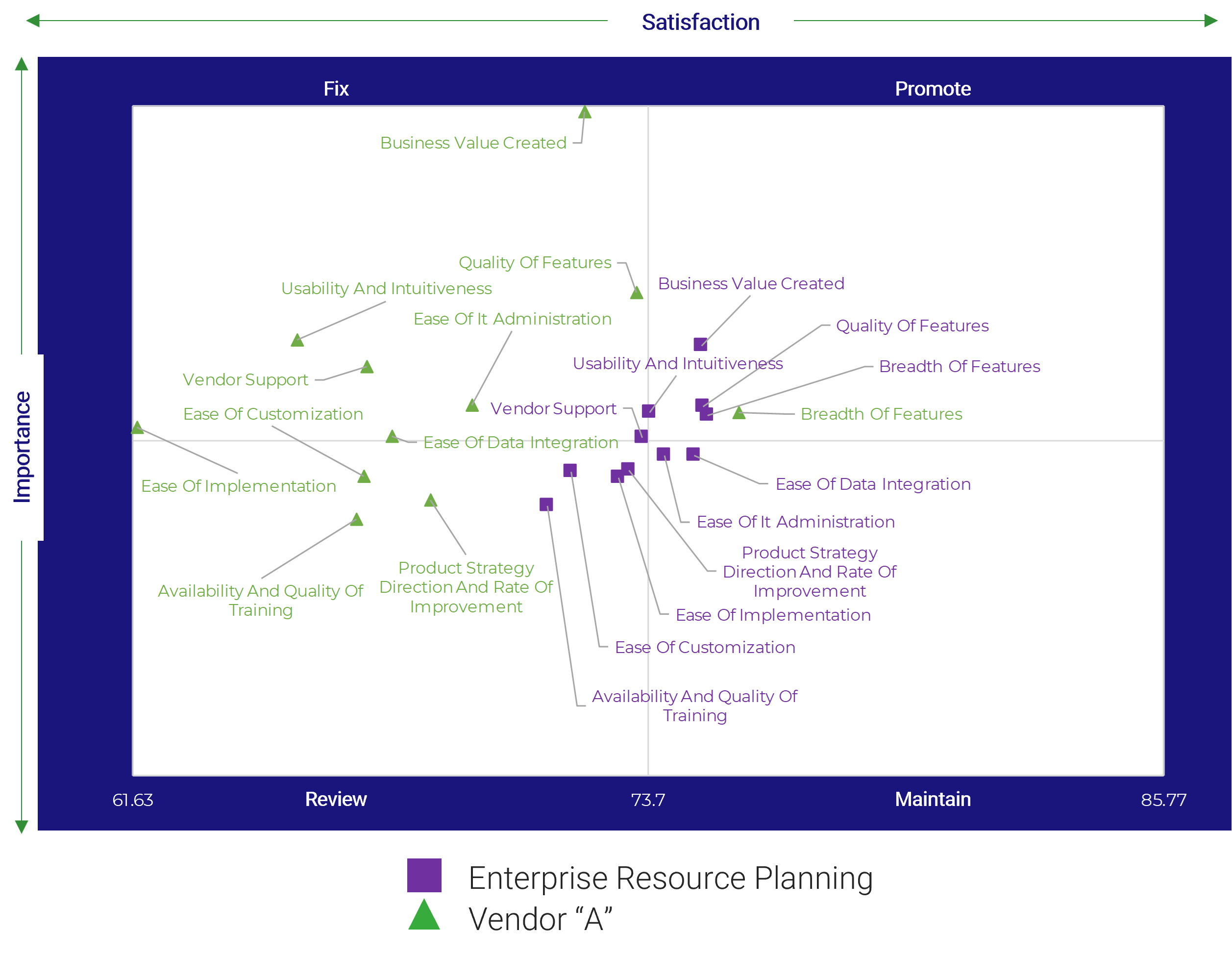
Capabilities in the “Fix” quadrant should be addressed in this GTM Strategy cycle.
Capabilities in the “Review” quadrant are low in both buyer satisfaction and importance, so vendors are wise to hold on further investments and instead focus on “Fix.”
Capabilities in the “Promote” quadrant are high in buyer importance and satisfaction, and should be called out in marketing and selling.
Capabilities in the “Maintain” quadrant are high in buyer satisfaction, but lower in importance than other features – maintain investments here.
(Optional for clients with buyer reviews and key competitive reviews within target product category.)
Develop a competitively differentiated value proposition
Combining internal competitive knowledge with insights from buyer interviews and buyer reviews; establish which key features that will competitively differentiate your product when delivered
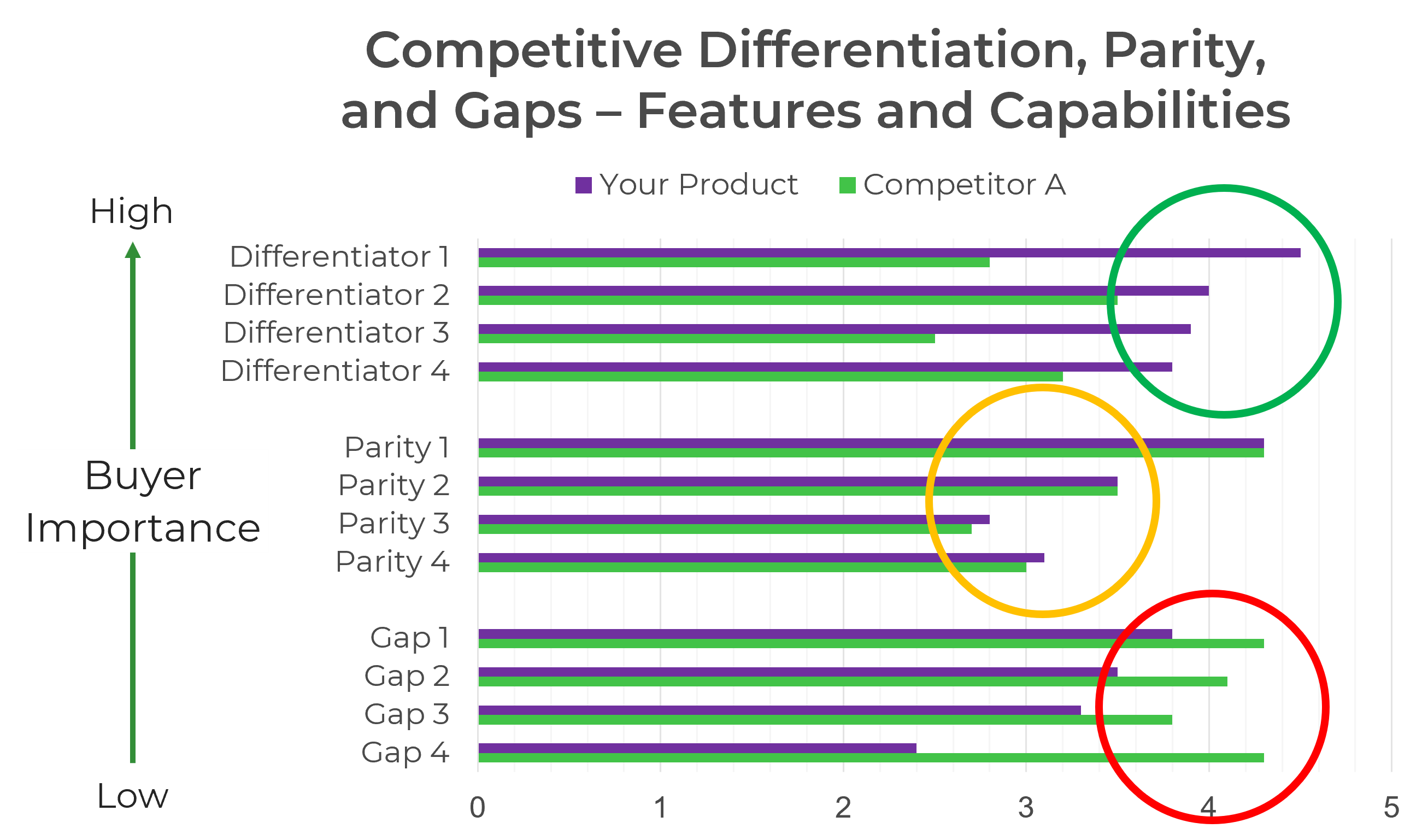
- Identify what buyers need that will differentiate your product features and company capabilities from key competitors.
- Determine which features and company capabilities, ideally lower in buyer importance, can achieve/maintain competitive parity.
- Determine which features and company capabilities, ideally much lower in buyer importance, that can exist in a state of competitive gap.
Step 1.7
Select the Most Effective Routes to Market
Activities
- 1.7.1 Understand a framework for deciding how to approach evaluating each available channel including freemium/ecommerce, inside sales, field sales, and channel partner.
- 1.7.2 Gather data that will inform option consideration.
- 1.7.3 Apply to decision framework and present to key stakeholders for a decision.
This step will provide processes to help you:
- Understand the areas to consider when choosing a sales channel
- Support your decision by making a specific channel recommendation
This step involves the following participants:
- Project workstream leads in Sales, Sales Operations, Product Marketing, and Customer Success
Outcomes of this step
- Clarity around channel choice for this specific go-to-market strategy cycle
- Pros and cons of choices with rationale for selected channel
Phase 1 - Formulate a hypothesis and run discovery on key fundamentals
| Step 1.1 | Step 1.2 | Step 1.3 | Step 1.4 | Step 1.5 | Step 1.6 | Step 1.7 | Step 1.8 |
Your “route-to-market” – channel strategy
Capture buyer channel preferences in Step 1.3, and research alternatives using the following framework
Inside vs. Field Sales – Selling software during COVID has taught us that you can successfully sell software using virtual conferencing tools, social media, the telephone, and even texting and webchat – so is the traditional model of field/territory-based sellers being replaced with inside/virtual sellers who can either work at home, or is there a benefit to being in the office with colleagues?
Solutions vs. Individual Products – Do your buyers prefer to buy a complete solution from a channel partner or a solutions integrator that puts all the pieces together, and can handle training and servicing, for a more complete buyer solution?
Channel Partner vs. Build Sales Force – Are there channel partners that, given your product is targeting a new buyer with whom you have no relationship, can leverage their existing relationships, quicken adoption of your products, and lower your cost of sales?
Fully Digital – Is your application one where users can get started for free then upgrade with more advanced features without the use of a field or inside sales person? Do you possess the e-commerce platform to support this?
While there are other considerations beyond the above to consider, decide which channel approach will work best for this GTM Strategy.
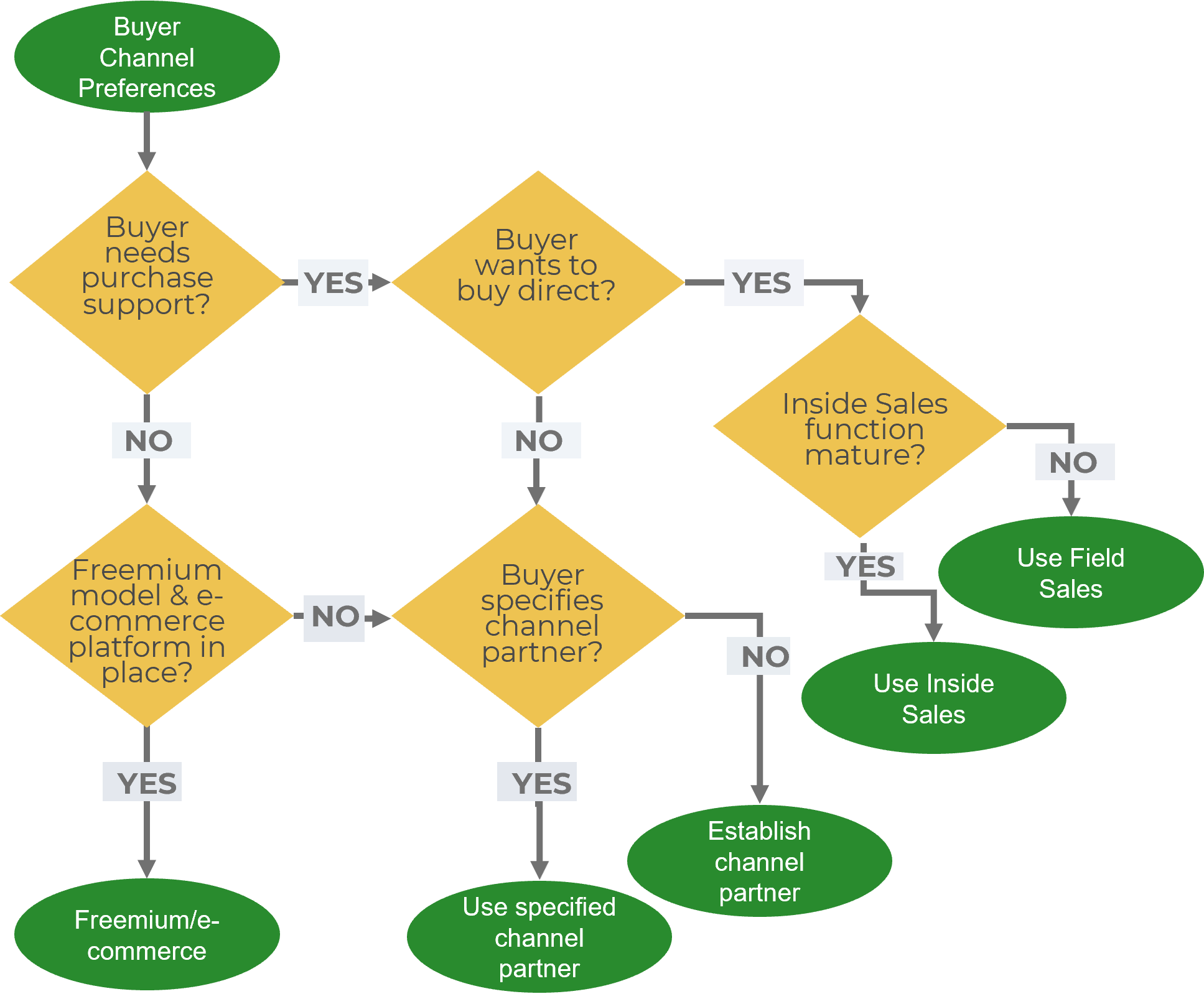
Channel Partnerships are Expanding
“One estimate is that for every dollar a firm spends on its SaaS platform, it spends four times that amount with systems integrators and other channel partners.
And as technologies are embedded inside other products, services, and solutions, effective selling requires more partners.
Salesforce, for example, is recruiting thousands of new partners, while Microsoft is reportedly adding over 7,000 partners each month.” (HBR, 2021)
Step 1.8
Craft an Initial GTM Strategy Presentation for Executive Review and Status Check
Activities
- 1.8.1 Finalize the set of slides within the Go-to-Market Strategy Presentation that best illustrates the many key findings and recommended decisions that have been made during the Explore phase of the GTM Strategy.
- Test whether all key deliverables have been created, especially those that must be in place in order to support future phases and steps.
- Schedule a Steering Committee meeting and present your findings with the goal to gain support to proceed to the Design phase of GTM Strategy.
This step will provide processes to help you:
- Work with your colleagues to consolidate the findings from Phase 1 of the GTM Strategy
- Create a slide deck with your colleagues for presentation to the Steering Committee to gain approvals to proceed to Phase 2
This step involves the following participants:
- Project workstream leads in Sales, Sales Operations, Product Marketing, and Customer Success
- Steering Committee
Outcomes of this step
- Slide deck to present to the Steering Committee
- Approvals to move to Phase 2 of the GTM Strategy
Phase 1 - Formulate a hypothesis and run discovery on key fundamentals
| Step 1.1 | Step 1.2 | Step 1.3 | Step 1.4 | Step 1.5 | Step 1.6 | Step 1.7 | Step 1.8 |
1.8.1 Build your GTM Strategy deck for Steering Committee approval
- As you near completion of the Go-to-Market Strategy Phase, Explore Step, an important test to pass before proceeding to the Design step of GTM Strategy, is to answer several key questions:
- Have you properly sized the market opportunity for the focus of this GTM cycle?
- Have you defined a unique value proposition of what buyers are looking for?
- And have you aligned stakeholders on the target customer persona and flushed out an accurate buyer journey?
- If the answer is “no” you need to return to these steps and ensure completion.
- Pull together a summary review deck, schedule a meeting with the Steering Committee, present to-date findings for approval to move on to Phase 2.
Download the Go-to-Market Strategy Presentation Template
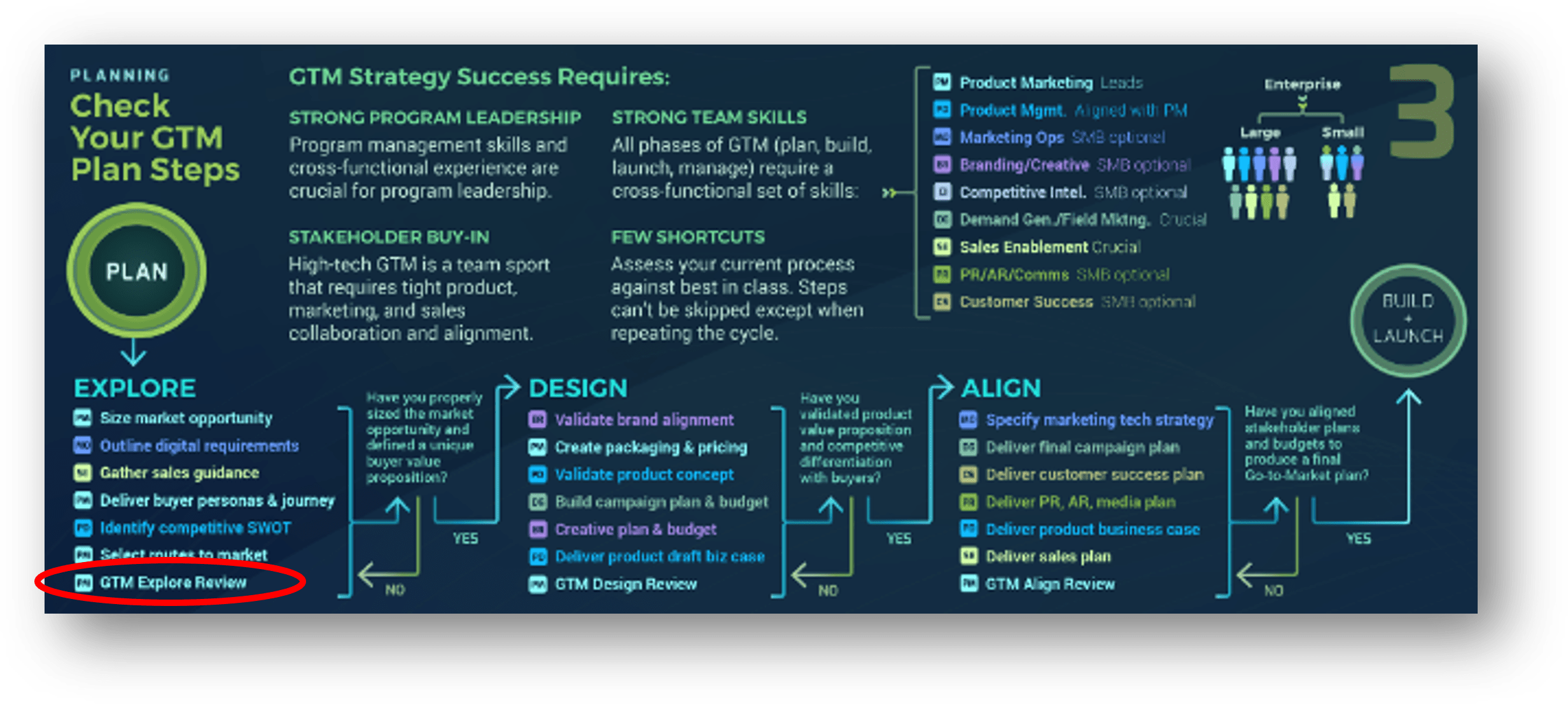
The presentation you create contains:
- Team composition and roles and responsibilities
- Steps in overall process
- Goals and objectives
- Timelines and work plan
- Initial product and launch concept
- Buyer persona and journey
- Competitive differentiation
- Channel strategy
Build a More Effective Go-to-Market Strategy
Phase 2
Design your initial product and business case
| Phase 1 1.1 Select Steering Cmte/team, build aligned vision for GTM 1.2 Buyer personas, journey, initial messaging 1.3 Build initial product hypothesis 1.4 Size market opportunity 1.5 Outline digital/tech requirements 1.6 Competitive SWOT 1.7 Select routes to market 1.8 Craft GTM Strategy deck | Phase 2 2.1 Brand consistency check 2.2 Formulate packaging and pricing 2.3 Craft buyer-valid product concept 2.4 Build campaign plan and targets 2.5 Develop cost budgets across all areas 2.6 Draft product business case 2.7 Update GTM Strategy deck | Phase 3 3.1 Assess tech/tools support for all GTM phases 3.2 Outline sales enablement and Customer Success plan 3.3 Build awareness plan 3.4 Finalize business case 3.5 Final GTM Plan deck |
This phase will walk you through the following activities:
- Branding consistency check
- Formulate packaging and pricing
- Craft buyer-validated product concept
- Build initial campaign plan and targets
- Develop budgets for creative, content, and media purchases
- Draft product business case
- Update GTM Strategy deck
This phase involves the following stakeholders:
- Steering Committee
- Working group leaders
To complete this phase, you will need:
| Go-to-Market Strategy Presentation Template | Go-to-Market Strategy RACI and Launch Checklist Workbook | Buyer Persona and Journey blueprint | Go-to-Market Strategy Cost Budget and Revenue Forecast Workbook |
 |  |  | 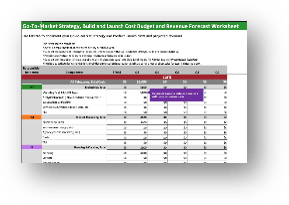 |
Use the Go-to-Market Strategy Presentation Template to document the results from the following activities:
| Use the Go-to-Market Strategy RACI and Launch Checklist Workbook to:
| Use the Buyer Persona and Journey blueprint to:
| Use the Go-to-Market Cost Budget and Revenue Forecast Workbook to:
|
Step 2.1
Compare Emerging Messaging and Positioning With Existing Brand for Consistency
Activities
Share messaging documented with the buyer journey with branding/creative and/or Marketing VP/CMO to ensure consistency with overall corporate messaging. Use the “Brand Diagnostic” on the following slide as a quick check.
For those marketers that see the need for a re-brand, please:
Download the Go-to-Market Strategy Presentation Template
Later during the Build phase of GTM, marketing assets, digital platforms, sales enablement, and sales training will be created where actual messaging can be written with brand guidelines aligned.
This step is to assess whether you we need to budget extra funds for any rebranding.
This step will walk you through the following activities:
- After completing the buyer journey and identifying messaging, test with branding/CMO that new messaging aligns with current:
- Company positioning
- Messaging
- Brand imagery
This step involves the following participants:
- Project lead
- Product marketing
- Branding/creative
- CMO
Outcomes of this step
- Check – Y/N on brand alignment
- Adjustments made to current branding or new product messaging to gain alignment
Phase 2 – Validate designs with buyers and solidify product business case
| Step 2.1 | Step 2.2 | Step 2.3 | Step 2.4 | Step 2.5 | Step 2.6 | Step 2.7 |
Brand identity
| Re-think tossing a new product into the same old marketing engine. Ask if your branding today and on this new offering needs help.
If you answer “no” to any of the following questions, you may need to re-think your brand. Does your brand:
|
“Nailing an impactful brand identity is a critical part of Growth Marketing. Without a well-crafted and maintained brand identity, your marketing will always feel flat and one-dimensional.” (Lean Labs, 2021) |
Step 2.2
Formulate Packaging and Pricing
Activities
- 2.2.1 Leverage what was learned in Phase 1 from buyer interviews to create an initial packaging and initial pricing approach.
- Packaging success is driven by knowing what the buyer values are, how newly proposed functionality may work with other applications, and how well the buyer(s) work in teams.
- Develop pricing using cost-plus, value/ROI, and competitive/market pricing comparisons.
This step will walk you through the following activities:
- Approaches to establishing price points for software products
- Checking if pricing supports emerging product revenue plan
This step involves the following participants:
- Project lead
- Product Marketing
- Product Management
- Pricing (if a function)
Outcomes of this step
- Pricing that is validated through buyer interviews and consistent with overall company pricing guardrails
- Packaging that can be delivered
Phase 2 – Validate designs with buyers and solidify product business case
| Step 2.1 | Step 2.2 | Step 2.3 | Step 2.4 | Step 2.5 | Step 2.6 | Step 2.7 |
2.2.1 Formulate packaging and pricing
Goal: Incorporate buyer benefits into your MVP that delivers the buyer value that compels them to purchase and drives the business case
Download the Go-to-Market Strategy Presentation Template | Refer to the findings from buyer persona interviews
|
Step 2.3
Build a Buyer-Validated Product Concept
Activities
- 2.2.1 Add to your initial product concept from Phase 1, the pricing and packaging approach.
- Take the concept out to buyers to get their feedback – not on UX design, that will come later, but to ensure the value is clear to the buyers, and to raise confidence in the product concept.
- As with previous customer and prospect interviews, use the Buyer Persona and Journey blueprint with its accompanying interview guide and focus on the product related questions.
- Generate your slides to present and discuss with buyers, capture feedback, and refine the product concept.
This step will walk you through the following activities:
- Hold buyer interviews to review the product design
- Validate concept and commercial variables – not UX design, that comes later
This step involves the following participants:
- Project lead
- Product Marketing
- Product Management
Outcomes of this step
- Customer validated product concept that meets the business plan
Phase 2 – Validate designs with buyers and solidify product business case
| Step 2.1 | Step 2.2 | Step 2.3 | Step 2.4 | Step 2.5 | Step 2.6 | Step 2.7 |
2.3.1 The best new product hypothesis doesn’t always come from your best customers
Goal: Validate your product concept and business case
Download the Go-to-Market Strategy Presentation Template | “Innovation opportunities almost always come from understanding a company’s worst customers or customers it doesn’t serve” (Harvard Business School Press, 1997) |
2.3.2 How your prospects buy will inform upcoming campaign design
Goal: During product validation interviews, further validate the buyer journey to identify asset types to be created/sourced for launch campaign design
Download the Go-to-Market Strategy Presentation Template | Refer to the findings from buyer persona interviews |
Answers you need to map buyer journey
Your buyer interviews – whether during earlier steps or here during product concept validation – will give specific answers to all areas in green text below. Understanding channels, asset-types, and crafting your key messaging are essential for next steps.
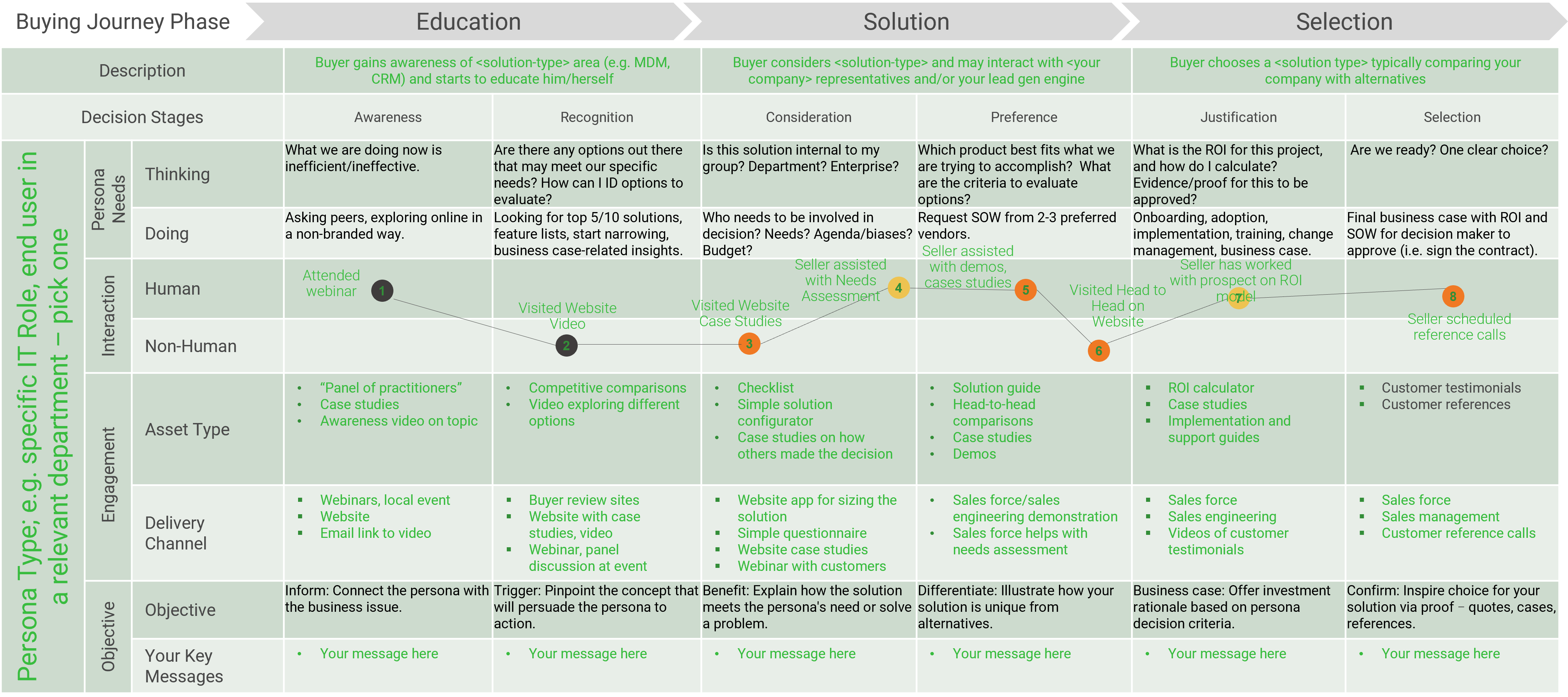
Step 2.4
Build Your Initial Campaign Plan and Targets
Activities
- 2.4.1. While product management and marketing is working on the business case, the campaign team is designing their launch campaign.
- Expand from the product concept and build out the entire launch campaign identifying dates, CTA’s, channels, and asset types needed that will be built during the Build phase.
This step will walk you through the following activities:
- Outline deployment plan of activities and outcomes
- Draw up specs for needed assets, web-page changes, emails, target segments, and targets for leads generated
This step involves the following participants:
- Project lead
- Field Marketing
- Product Marketing
Outcomes of this step
- The initial draft of the campaign plan that outlines multichannel activities, dates, and assets that need to be sourced and/or created
Phase 2 – Validate designs with buyers and solidify product business case
| Step 2.1 | Step 2.2 | Step 2.3 | Step 2.4 | Step 2.5 | Step 2.6 | Step 2.7 |
2.4.1 Document your campaign plan
2 hours
On the following Awareness and Lead Gen Engine slide:
On the Product and Launch Concept slides:
Download the Go-to-Market Strategy Presentation Template | “Only 32% of marketers – and 29% of B2B marketers – said the process of planning campaigns went very well. Just over half were sure they had selected the right business goal for a given marketing project and only 42% were confident they identified the right audience – which is, of course, a critical determinant for achieving success.” (MIT Sloan Management Review) |
Launch campaign
Our Goal for [Campaign name] is to generate X SQL’s
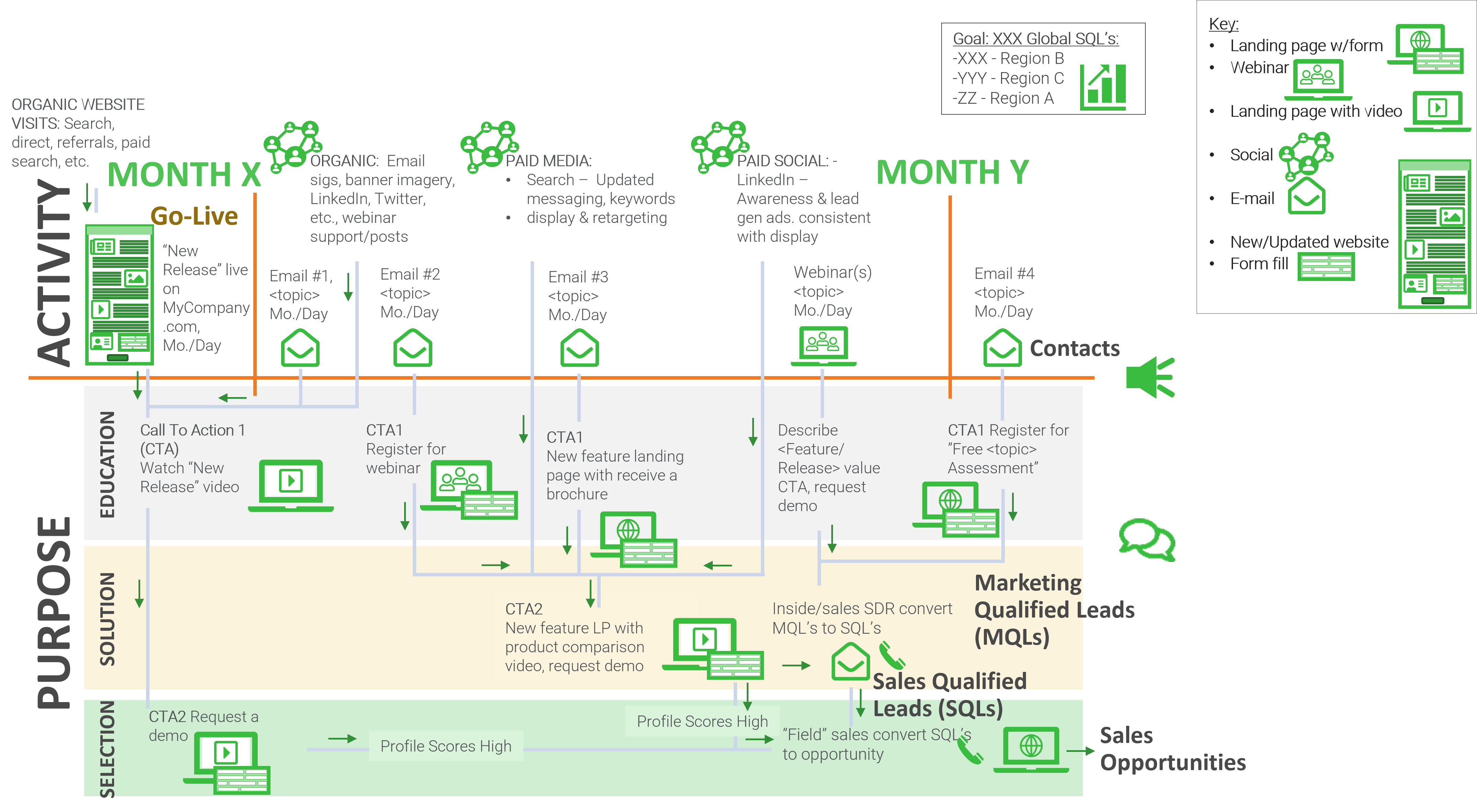
Awareness
PR/EXTERNAL COMMS:
Promote release in line with company story
- [Executive Name] interview with [Publication Y] on [Launch Topic X] – Mo./Day
- Press Release on new enhancements – Mo./Day
- [Executive Name] interview with [Publication Z] on [Launch Topic X] – Mo./Day
ANALYST RELATIONS:
Receive analyst feedback pre-launch and brief with final releases messaging/positioning
- Inquiry with [Key Analysts] on [Launch Topic X] – Mo./Day, pre launch
- Press Release shared on new enhancements – Launch day minus two days
- Analyst briefing with [Key Analysts] on [Launch Topic X] – Launch day minus two days
Download the Go-to-Market Strategy Presentation Template
2.4.2 Campaign targets
Goal: Establish a Marketing-Influenced Win target that will be achieved for this launch
We advise setting a target for the launch campaign. Here is a suggested approach:
Download the Go-to-Market Strategy Presentation Template | “Marketing should quantify its contribution to the business. One metric many clients have found valuable is Marketing Influenced Wins (MIW). Measured by what % of sales wins had a last-touch marketing attribution, marketers in the 30% – 40% MIW range are performing well.” (SoftwareReviews Advisory Research) |
Step 2.5
Develop Initial Budgets Across All Areas
Activities
- 2.5.1 Use the Go-to-Market Budget Workbook and work with your workstream leads.
- Capture the costs associated with this GTM Strategy and Launch.
- Summarize your GTM budget in the Go-to-Market Strategy Presentation, including the details behind the gross margin calculation for your GTM Strategy/campaign if required.
This step will walk you through the following activities:
- Field marketing, product marketing, creative, others to identify the specific budget elements needed for this campaign/launch
This step involves the following participants:
- Project lead
- Field Marketing
- Product Marketing
- Branding/creative
Outcomes of this step
- The initial marketing budget for this campaign/launch
Phase 2 – Validate designs with buyers and solidify product business case
| Step 2.1 | Step 2.2 | Step 2.3 | Step 2.4 | Step 2.5 | Step 2.6 | Step 2.7 |
Download the Go-to-Market Strategy Cost Budget and Revenue Forecast Workbook
2.5.1 Develop your GTM Strategy/product launch campaign budget
Goal: Work with your workstream leads to identify all incremental costs associated with this GTM strategy and product launch
- Use the Go-to-Market Budget Workbook and adjust to include the areas that are identified by your workstream leads as being applicable to this GTM Strategy and Launch.
- These should be incremental costs to normal operating and capital budgets and those areas that are fully approved for inclusion by your Steering Committee/Sponsoring Executive.
- Begin to Catalog all applicable costs to include all key areas such as:
- Technology costs for internal use (typically from Marketing Ops), and “core” to product technology costs working with the product team
- Channel marketing programs, agency (e.g. branding, naming, web design, SEO, content marketing, etc.), T&E, paid media, events, marketing assets, etc.
- Summarize your initial GTM budget findings in the Go-to-Market Strategy Presentation, including the details behind the gross margin calculation for your GTM Strategy/campaign if required. Again, you will flush out the final costs within each workstream areas in Phase 3, ”Align.”
Note that in the Align Step – Step 3, you will see your workstream leads each develop their individual contributions to both the launch plan as well a budget.
Download the Go-to-Market Strategy Cost Budget and Revenue Forecast Workbook
Download the Go-to-Market Strategy Presentation Template
Step 2.6
Draft Initial Product Business Case
Activities
- 2.6.1 Here’s where you begin to pull together all the essential elements of your final business case.
- For many organizations that require a view of return on investment, you will begin here to shape the key elements that your organization requires for a complete business case to go ahead with the needed investments.
- The goal is to compare estimated costs to estimated revenues to ensure acceptable margins will be delivered for this GTM strategy/product launch.
- The culmination of work to get to this calculation will continue through Phase 3; however, the following slide illustrates the kind of visualization that will be possible with our approach.
This step will walk you through the following activities:
- A product revenue forecast is created, alignment with sales/sales targets is created for a minimum viable product (MVP) that meets the buyer’s needs at the price point established/validated
This step involves the following participants:
- Project lead
- Product management
- Product marketing
- Sales leadership
Outcomes of this step
- The important measures of:
- Product revenue forecast
- Supported MVP features
Phase 2 – Validate designs with buyers and solidify product business case
| Step 2.1 | Step 2.2 | Step 2.3 | Step 2.4 | Step 2.5 | Step 2.6 | Step 2.7 |
Gross Margin Estimates – part of a complete product business case
Your goal: Earn more than you spend! This projection of estimated gross margins should be part of your product launch business case. The GTM initiative lead and workstream leads are charged with estimating incremental costs, and product and sales must work together on the revenue forecast.
Net ReturnWe estimate our 12 month gross profit to be …. Quarterly RevenuesBased on sales forecast, our quarterly/monthly revenues are …. Estimated ExpensesIncremental up-front costs are expected to be …. |

|
2.6.1 Develop your initial product business case
Goal: Focused on the Product Concept areas related to product Market Fit, Buyer Needs and Market Opportunity, Product Managers will summarize in order to gain approval for Build
|
Product Business Case Checklist:
|
Download the Go-to-Market Strategy Cost Budget and Revenue Forecast Workbook
Download the Go-to-Market Strategy Presentation Template
Step 2.7
Update the GTM Strategy Presentation Deck for Executive Review and Sign-off
Activities
- 2.7.1 Update the deck with Phase 2 findings culminating in the business case.
This step will walk you through the following activities:
- Drop into the GTM Strategy deck the summary findings from the team’s work
- Write an executive summary that garners executive support for needed funds, signed-up-for sales targets, agreed upon launch timing
- Steering Committee alignment on above and next steps
This step involves the following participants:
- Project lead
- Steering Committee
- Workstream leads
Outcomes of this step
- Executive support for the GTM Strategy plan and approval to proceed to Phase 3
Phase 2 – Validate designs with buyers and solidify product business case
| Step 2.1 | Step 2.2 | Step 2.3 | Step 2.4 | Step 2.5 | Step 2.6 | Step 2.7 |
2.7.1 Update your GTM Strategy deck for Design Steering Committee approval
- As you near completion of the Go-to-Market Strategy Phase – Design Step, while your emerging business case is important, it will be finalized in the Align Step.
- An important test to pass before proceeding to the Align step of the GTM Strategy, is to answer several key questions:
- Have you validated the product value proposition with buyers?
- Is the competitive differentiation clear for this offering?
- Did Sales support the business case by signing up for the incremental quota?
- Has product defined an MVP that aligns with the buyer value needed to drive purchases?
- If the answer is “no” you need to return to these steps and ensure completion
- Pull together a summary review deck, schedule a meeting with the Steering Committee, and present to-date findings for approval to move onto Phase 3.
Download the Go-to-Market Strategy Presentation Template
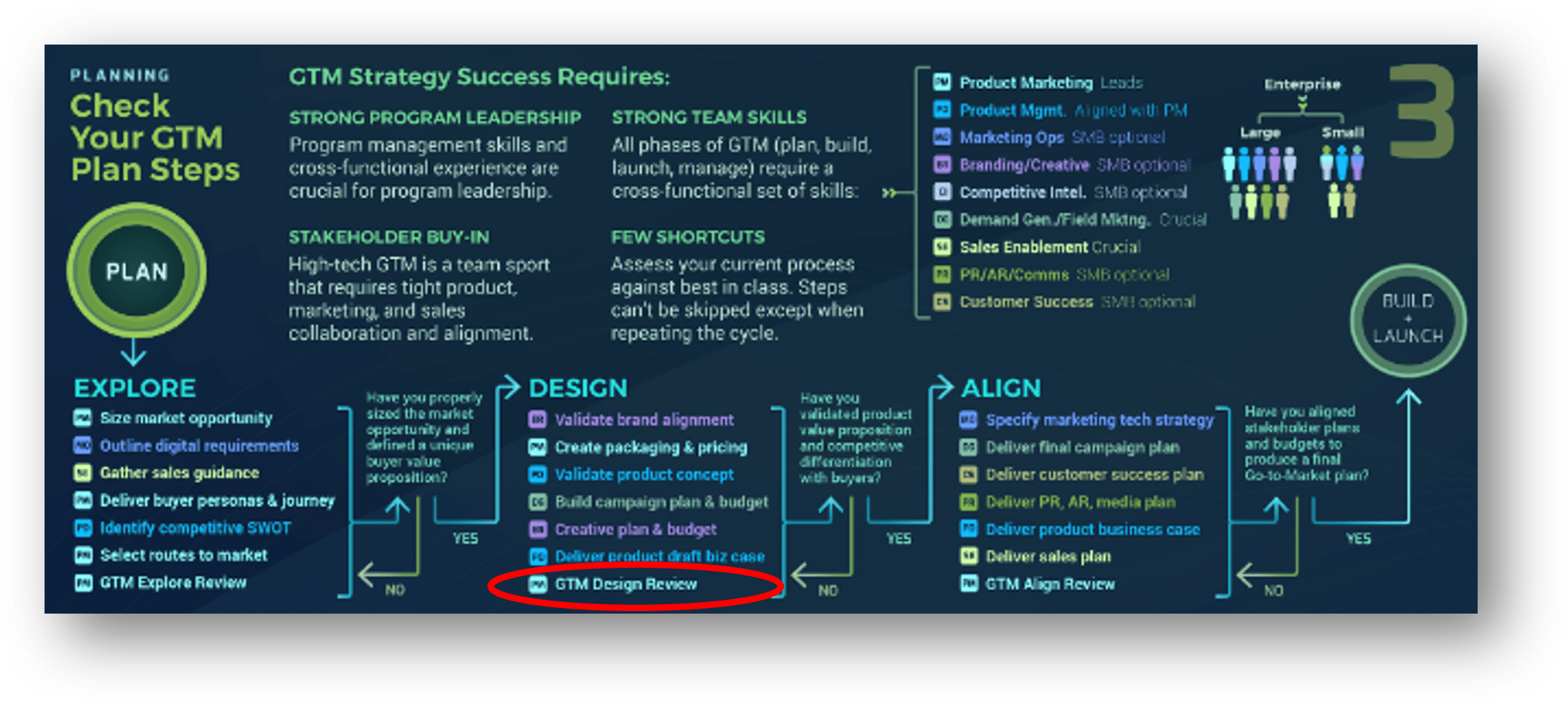
The presentation you create contains:
- Timelines and a work plan
- Expanded product concept to include your packaging and pricing approach
- Feedback from buyers on validated product concept especially commercial elements
- Expanded campaign plan and marketing budget
- Initial product business case
Build a More Effective Go-to-Market Strategy
Phase 3
Align stakeholder plans to prep for build
| Phase 1 1.1 Select Steering Cmte/team, build aligned vision for GTM 1.2 Buyer personas, journey, initial messaging 1.3 Build initial product hypothesis 1.4 Size market opportunity 1.5 Outline digital/tech requirements 1.6 Competitive SWOT 1.7 Select routes to market 1.8 Craft GTM Strategy deck | Phase 2 2.1 Brand consistency check 2.2 Formulate packaging and pricing 2.3 Craft buyer-valid product concept 2.4 Build campaign plan and targets 2.5 Develop cost budgets across all areas 2.6 Draft product business case 2.7 Update GTM Strategy deck | Phase 3 3.1 Assess tech/tools support for all GTM phases 3.2 Outline sales enablement and Customer Success plan 3.3 Build awareness plan 3.4 Finalize business case 3.5 Final GTM Plan deck |
This phase will walk you through the following activities:
- Assess tech/tools support for all GTM phases
- Map lead generation plan
- Outline Customer Success plan
- Build awareness plan (PR/AR, etc.)
- Finalize product business case
- Final GTM planning deck and Steering Committee review
This phase involves the following stakeholders:
- Steering Committee
- Working group leaders
To complete this phase, you will need:
| Go-to-Market Strategy Presentation Template | Go-to-Market Strategy Cost Budget and Revenue Forecast Workbook |

|

|
Use the Go-to-Market Strategy Presentation Template to document the results from the following activities:
|
Use the Go-to-Market Cost Budget and Revenue Forecast Workbook to:
|
Step 3.1
Assess Technology and Tools Support for Your GTM Strategy as Well as Future Phases of GTM
Activities
- 3.1.1 Have Marketing Operations document what tech stack improvements are required in order to get the team to a successful launch. Understand costs and implementation timelines and work it into the Go-to-Market Budget Workbook.
This step will walk you through the following activities:
- After completing your initial survey in Step 1, complete requirements building for needed technology and tools acquisition/upgrade in campaign management, sales opportunity management, and analytics.
This step involves the following participants:
- Project lead
- Marketing operations/digital
- IT
Outcomes of this step
- Build a business requirement against which to evaluate new/upgraded vendor tools to support the entire GTM process
Phase 3 – Align functional plans with a compelling business case for product build
| Step 3.1 | Step 3.2 | Step 3.3 | Step 3.4 | Step 3.5 |
3.1.1 Technology plan and investments
Goal: Outline the results of our analysis and Info-Tech analyst guidance regarding supporting systems, tools, and technologies to support our go-to-market strategy
- Plans, timings, and incremental costs related to, but not limited to, the following apps/tools/technologies:
- Lead management/Marketing automation
- Marketing analytics
- Sales Opportunity Management System (OMS) and Configure, Price, and Quote (CPQ) applications
- Sales engagement
- Sales analytics
- Customer service and support/Customer interaction hub
- Customer data management and analytics
- Customer experience platforms
- Marketing content management
- Creative tools
- Share of voice and social platform management
- Etc.
- Go to the Go-to-Market Budget Workbook and complete by adding costs identified in above areas that are specific to this go-to-market strategy, Build, and Launch initiative. Record in the Go-to-Market Strategy Presentation completing the areas within the slides related to the Product and Launch Concepts and Business Case.
Download the Go-to-Market Strategy Cost Budget and Revenue Forecast Workbook
Download the Go-to-Market Strategy Presentation Template
Step 3.2
Outline Sales Enablement and Support for Customer Success to Include Onboarding and Ongoing Engagement
Activities
- 3.3.1 Sales Enablement – develop the sales enablement and training plan for Launch to include activities, responsible parties, dates for delivery, etc.
This step will walk you through the following activities:
- Finalize the customer success training and support plan
- Onboarding scripts
- Changes to help screens in application
- Timing to plan for Quality Acceptance
This step involves the following participants:
- Project lead
- Customer Success lead
- Product management
- Product marketing
Outcomes of this step
- Plan for creation of copy, assets, and rollout pan to support clients and client segments for Launch
Phase 3 – Align functional plans with a compelling business case for product build
| Step 3.1 | Step 3.2 | Step 3.3 | Step 3.4 | Step 3.5 |
3.2.1 Outline sales enablement
Goal: Outline sales collateral, updates to sales proposals, CPQ, Opportunity Management Systems, and sales training
- Describe the requirements for sales enablement to include elements such as:
- Sales collateral
- Client-facing presentations
- Sales proposal updates
- Updates to Configure, Price, and Quote (CPQ) applications
- Updates to Opportunity Management System (OMS) applications
- Sales demo versions of the new product
- Sales communication plans
- Sales training and certification programs
- Go to the Go-to-Market Budget Workbook and add the costs identified in above areas that are specific to this go-to-market strategy, Build, and Launch initiative. Record as well in the Go-to-Market Strategy Presentation completing the areas within the slides related to the Product and Launch Concepts and Business Case.
Download the Go-to-Market Strategy Cost Budget and Revenue Forecast Workbook
Download the Go-to-Market Strategy Presentation Template
3.2.2 Outline customer success
Goal: Outline customer support/success requirements and plan
- Plans, timings, and incremental costs for the following:
- Onboarding scripts for the new solution
- Updates to retention lifecycle
- FAQ answers
- Updates to online help/support system
- “How-to” videos
- Live chat updates
- Updates to “provide feedback” system
- Updates to Quarterly Business Review slides
- Go to the Go-to-Market Budget Workbook and add the costs identified in above areas that are specific to this go-to-market strategy, Build, and Launch initiative. Record in the Go-to-Market Strategy Presentation and complete the areas within the slides related to the Product and Launch Concepts and Business Case.
Download the Go-to-Market Strategy Cost Budget and Revenue Forecast Workbook
Download the Go-to-Market Strategy Presentation Template
Step 3.3
Build an Awareness Plan Covering Media, Social Media, and Industry Analysts
Activities
- 3.4.1 Corp Comms/PR/AR – develop the overall awareness plans for executive interviews, articles placed, social drops, analyst briefing dates, and internal associate comms if required.
This step will walk you through the following activities:
- Outline outbound communications plans including press releases, social posts, etc.
- Describe dates for AR outreach to covering analysts
- Develop the internal communications plan
This step involves the following participants:
- Project lead
- Corporate Comms lead
- Creative
- Analyst relations
- Social media marketing lead
Outcomes of this step
- Plan for creation of copy, assets, and rollout pan to support awareness building, external communications, and internal communications if required
Phase 3 – Align functional plans with a compelling business case for product build
| Step 3.1 | Step 3.2 | Step 3.3 | Step 3.4 | Step 3.5 |
3.3.1 Internal communications plan
Goal: Outline complete internal communications plan. For large-scale changes (i.e. rebranding, M&A, etc.) HR may drive significant volume of employee communications working with Corporate Comms
- Plans, timings, and incremental costs for the following:
- Complete a comms plan with dates, messages, and channels
- Team member roles and responsibilities
- Intranet article and posting schedules
- Creation of new office signage, merchandise, etc. for employee kits
- Pre-launch announcements schedule
- Launch day communications, events, and activities
- Post launch update schedule and messages for launch success
- Incremental staffing and resources/budget requirements
- Go to the Go-to-Market Budget Workbook and add costs identified in above areas that are specific to this go-to-market strategy, Build, and Launch initiative. Record as well in the Go-to-Market Strategy Presentation completing the areas related to the Product and Launch Concepts and Business Case.
Download the Go-to-Market Strategy Cost Budget and Revenue Forecast Workbook
Download the Go-to-Market Strategy Presentation Template
3.3.2 PR and External Communications Plan
Goal: Outline complete internal communications plan. For large scale changes (i.e. rebranding, M&A, etc.) HR may drive significant volume of employee communications working with Corporate Comms
- Plans, timings, and incremental costs for the following:
- List of Tier 1 and Tier 2 media authors covering the [product/initiative] market area
- Schedule of launch briefings, with any non-analyst influencers
- Timing of press releases
- Required supporting executives and stakeholders for each of the above meetings
- Slide deck/media kit for the above and planned questions to support needed feedback
- Media Site materials especially to support media questions and requests for briefings
- Social postings calendar of activities and key messages plan
- Publish data of [product/initiative] relevant articles with set-back schedules
- Cultivation of reference customers and client testimonials for media outreach
- Requirements for additional staffing to cover product/initiative new market and analysts
- Internal and external events calendar to invite media
- Go to the Go-to-Market Budget Workbook and add the costs identified in the above areas that are specific to this go-to-market strategy, Build, and Launch initiative. Record in the Go-to-Market Strategy Presentation by completing the areas related to the Product and Launch Concepts and Business Case.
Download the Go-to-Market Strategy Cost Budget and Revenue Forecast Workbook
Download the Go-to-Market Strategy Presentation Template
3.3.3 Analyst relations plan
Goal: Outline incremental costs in analyst communications, engagement, and access to research
- Plans, timings, and incremental costs for the following:
- List of Tier 1 and Tier 2 analysts for the [product/initiative] market area
- Schedule of inquiries, pre-launch briefings, launch briefings, and post-launch feedback
- Required supporting executives and stakeholders for each of the above meetings
- Analyst deck for each of the above and planned questions to support needed feedback
- Analyst Site materials to support 2nd and 3rd Tier analysts’ questions and requests for briefings
- Social postings calendar of activities and key messages
- Resources to respond to analyst blogs and/or social posts regarding your product/initiative area
- Timing of important and relevant analyst document/methodology publishing dates with set-back schedules
- Cultivation of reference customers and client testimonials to coincide with analyst outreach for research and for buyer review sites/reviews data gathering
- Requirements for additional staffing to cover product/initiative new market and analysts
- Events calendar where analysts will be presenting on this product/initiative market
- Go to the Go-to-Market Budget Workbook and add the costs identified in the above areas that are specific to this go-to-market strategy, Build and Launch initiative. Record in the Go-to-Market Strategy Presentation by completing the areas related to the Product and Launch Concepts and Business Case.
Download the Go-to-Market Strategy Cost Budget and Revenue Forecast Workbook
Download the Go-to-Market Strategy Presentation Template
Step 3.4
Finalize Product Business Case With Collaborative Input From Product, Sales, and Marketing
Activities
- 3.5.1 Convene the team to align sales, marketing, and product around the business case.
This step will walk you through the following activities:
- Refine the product business case initiated in Phase 2
- Align product revenue forecast with sales revenue forecast
- Align MVP features to be developed during “GTM – Build” with customer validated product-market fit
This step involves the following participants:
- Project lead
- Product management
- Product marketing
Outcomes of this step
- Product business case
Phase 3 – Align functional plans with a compelling business case for product build
| Step 3.1 | Step 3.2 | Step 3.3 | Step 3.4 | Step 3.5 |
3.4.1 Final product Build and Launch business case
Goal: Beyond the product business case, factor in costs for technology, campaigning, sales enablement, and customer success in order to gain approval for Build and Launch
Go to the Go-to-Market Budget Workbook as outlined in prior steps and document final incremental costs and projected revenues and summarize within the Go-to-Market Strategy Presentation. Download the Go-to-Market Strategy Cost Budget and Revenue Forecast Workbook Download the Go-to-Market Strategy Presentation Template | Product Build and Launch Business Case Checklist:
|
Step 3.5
Develop Your Final Executive Presentation to Request Approval and Proceed to GTM Build Phase
Activities
- 3.6.1 Update the Product, Launch, Journey, and Business Case slides included within the Go-to-Market Strategy Presentation Template with Phase 3 findings culminating in the business case.
This step will walk you through the following activities:
- Update the previously created slides with findings from Phase 3
- Hold a Steering Committee meeting and present findings for approval
This step involves the following participants:
- Steering Committee
- Workstream leads
Outcomes of this step
- GTM Strategy approved to move to GTM Build
Phase 3 – Align functional plans with a compelling business case for product build
| Step 3.1 | Step 3.2 | Step 3.3 | Step 3.4 | Step 3.5 |
3.5.1 Update your GTM Strategy deck for Align Steering Committee approval
- As you near completion of the Go-to-Market Strategy Phase – Align Step, an important test to pass before proceeding to the Design step of GTM Strategy, is to answer several key questions:
- Are Sales, Product, and Marketing all aligned and in agreement on the business case?
- Are the gross margin calculations acceptable to the Steering Committee? CFO? CEO?
- If the answer is “no” you need to return to prior steps and ensure completion.
- Pull together a summary review deck, schedule a meeting with the Steering Committee, present to-date findings for approval to move on to Build Phase.
- Once your final business case is accepted, you are ready to move on to the GTM Build and Launch phases. These phases are covered in sperate SoftwareReviews blueprints.
Download the Go-to-Market Strategy Presentation Template
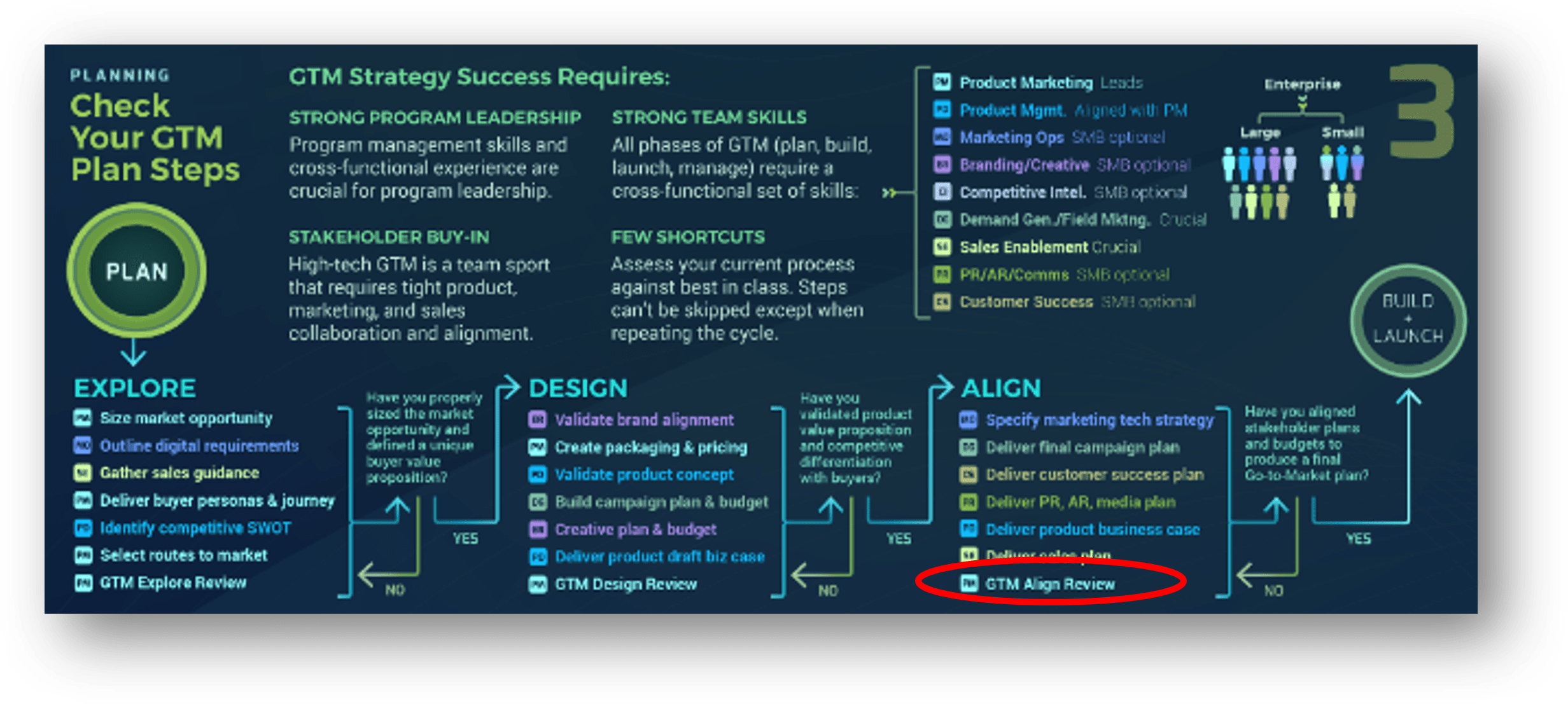
The presentation you create contains:
- Timelines and work plan updates
- Tech stack needs/modifications
- An expanded product concept to include packaging and pricing approach
- Asset-type concepts for marketing campaigns, sales collateral, website, and social
- Outline of initial Launch dates
- Outline of initial customer success, awareness/PR/AR plans, and sales training plans
- Final business case
Summary of Accomplishment
Problem Solved – A More Effective Go-to-Market Strategy
By guiding your team through the Go-to-Market planning process applied to an actual GTM Strategy, you have built an important set of capabilities that underpins today’s well-managed software companies. By following the step-by-step process outlined in this blueprint, you have delivered a host of benefits that include the following:
- Alignment of Product, Marketing, Sales, and Customer Success around a deeper understanding of your target buyers and what it takes to build competitive differentiation.
- You have calculated your product market opportunity and whether it’s worth the investment in the long-term, and for the short term you have estimated gross margins as an important part of the business case.
- Built executive support and confidence by leading a disparate team in complex decision making that is fact and evidence based to make more effective go/no go decisions related to investing in new products.
- And finally, because you and your team have demonstrated their ability to align programs toward a common goal and program-manage a complex initiative through to successful completion, you have led your team to develop the “institutional muscle” to take on equally complex initiatives such as acquisition integration, rebranding, launching in a new region, etc.
Therefore, developing the capabilities to manage a complex go-to-market strategy is akin to building company scalability and is sought after as a professional development opportunity that each executive should have on his/her résumé.
If you would like additional support, contact us and we’ll make sure you get the professional expertise you need.
Contact your account representative for more information.
info@softwarereviews.com 1-888-670-8889
Bibliography
Acosta, Danette. “Average Customer Retention Rate by Industry.” Profitwell.com. Accessed Jan. 2022.
Ashkenas, Ron, and Patrick Finn. “The Go-To-Market Approach Startups Need to Adopt.” Harvard Business Review, June 2016. Accessed Jun. 2021.
Bilardi, Emma. “ How to Create Buyer Personas.” Product Marketing Alliance, July 2020. Accessed Dec. 2021.
Cespedes, Frank V. “Defining a Post-Pandemic Channel Strategy.” Harvard Business Review, Apr. 2021. Accessed Jul. 2021.
Chapman, Lawrence. “A Visual Guide to Product Launches.” Product Marketing Alliance. Accessed Jul. 2021.
Chapman, Lawrence. “Everything You Need To Know About Go-To-Market Strategies.” Product Marketing Alliance. Accessed Jul. 2021.
Christiansen, Clayton. “The Innovators Dilemma.” Harvard Business School Press, 1997.
Drzewicki, Matt. “Digital Marketing Maturity: The Path to Success.” MIT Sloan Management Review. Accessed Dec. 2021.
“Go-To-Market Refresher,” Product Marketing Alliance. Accessed Jul. 2021
Harrison, Liz; Dennis Spillecke, Jennifer Stanley, and Jenny Tsai. “Omnichannel in B2B sales: The new normal in a year that has been anything but.” McKinsey & Company, 15 March, 2021. Accessed Dec. 2021.
Jansen, Hasse. “Buyer Personas – 33 Mind Blowing Stats.” Boardview, 19 Feb. 2016. Accessed Jan. 2022.
Scott, Ryan. “Creating a Brand Identity: 20 Questions to Consider.” Lean Labs, Jun 2021. Accessed Jul. 2021.
Smith, Michael L., and James Erwin. “Role and Responsibility Charting (RACI).” DOCSearch. Accessed Jan. 2022. Web.
“What is the Total Addressable Market (TAM).” Corporate Finance Institute (CFI), n.d. Accessed Jan. 2022.
Related Software Reviews Research
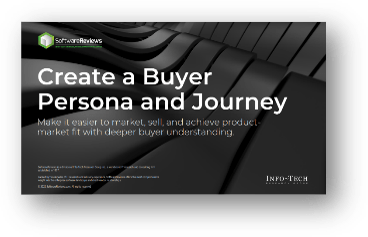
|
Create a Buyer Persona and Journey
|
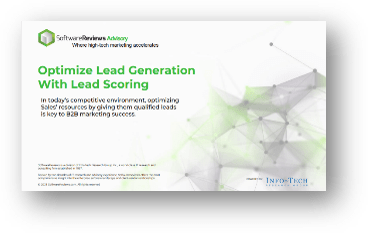
|
Optimize Lead Generation With Lead Scoring
|
